
magazine
Concordia College // Moorhead, Minnesota // winter 201 9 12 8 24 LIFE IMITATING ART 36
a
diverse future leading athletics learning by doing

Dear Alumni and Friends,
As he stood on the lawn outside of Bishop Whipple Hall for the celebration of Concordia’s 125th year, Professor Emeritus Olin Storvick gathered us all around him for a toast in honor of the college. Given Olin’s long career as a gifted teaching scholar, he might well have spoken of Concordia’s past. But he did not. He raised a glass and invited us to toast “the Concordia that is yet to be.” For me, and everyone else there, it became a defining moment, a moment in which we knew that sustaining our mission will require ongoing reformation for the sake of our students who will influence the affairs of the world.
In that spirit, we have launched into a new round of planning for the Concordia of 2023 – and beyond. As I write, more than 550 faculty, staff, students, and graduates have responded to questions – in person and online – about their hopes for our future. Those interactions have been ably led by the 24 members of our planning steering committee: faculty, staff, and students who have devoted long hours to this communal endeavor and who will continue their leadership through this coming spring. The committee met with our governing board in September, will meet with them at their January meeting, and will conclude their service as we present the regents with a recommended plan in May 2019.
In this work, we build on the achievements of the plan launched in 2012, titled Whole Self, Whole Life, Whole World. To view the completed report on the accomplishments of that plan, please visit our website at ConcordiaCollege.edu/StrategicSummary2018. Highlights include:
• Designing, funding, and building the Integrated Science Center
• Adopting the new PEAK requirement in applied learning for all students
• Creating new majors in Computer Science, Finance, Heritage and Museum Studies, and Neuroscience
• Launching the Concordia Career Initiative for all students across all four years of study
• Unifying all forms of student support in the new division of Student Development and Campus Life
• Establishing Concordia as a national leader in interfaith study, dialogue, and service
• Opening the Office of Diversity and recruiting a more diverse student body
• Achieving the designation as a National Language Training Center for Concordia Language Villages
The new plan for the college will sustain these achievements and build on the commitment to educate the whole self, for the whole of life, for the sake of the whole world. The plan will be deeply rooted in our statement of mission, composed by Dr. Carl Bailey almost 60 years ago and as compelling for us now as then. We’re in the thick of engaging everyone who loves Concordia in envisioning that plan, and so now is not the moment to declare final goals. That will come in May.
Yet already, key themes are emerging from students, graduates, staff, faculty, and members of our governing board:
• A defining commitment to experiential learning that guides students to take what they are learning in our liberal arts curriculum and apply it to real problems, in real communities, in real time. If we do this, our students will become creators of knowledge, and creators of vibrant communities – now and throughout their lives.
• A defining commitment to learning for democratic citizenship that takes advantage of Concordia’s unique position on the border of Minnesota and North Dakota, that builds on our commitments to diversity and sustainability, and that establishes us as a college that practices a vigorous civility in a time of sharp national divisions. If we do this, our students will become leaders in a nation and in a world that so much needs their gifts.
• A defining commitment to the health and well-being of every person who studies, lives, or works at Concordia and Concordia Language Villages. If we do this, we will model a life of personal, professional, and spiritual growth in service of community.
What fun this will be! Everyone who loves Concordia has a place at the table as we frame the vision for the Concordia that is yet to be.
 President William J. Craft
President William J. Craft
On the Cover
As exemplified in one of his most iconic woodcuts, “Cathedral Forest,” Charles Beck ’48 was inspired by the beauty of the Midwestern landscapes surrounding his hometown of Fergus Falls, Minn.
2 News 16 Enrollment
29 Alumni

12 Learning by Doing
Preparing students for today’s workforce through PEAK experiences
features
8
Broadening the Concordia Story
Becoming intentional about diversity
18
Partnership in Port-au-Prince Cobbers collaborate in Haiti to promote health
VP for Enrollment and Marketing: Dr. Karl A. Stumo ’92 // Editor: Joshua Lysne ’96 // Managing Editor: Laura Caroon ’06 // Art Direction: Caleb Fugleberg
22
New Home for Language
Breaking ground on a site for Korean
24
A Legacy in Leadership Bergeson named new athletic director
Concordia Magazine Winter 2019 Volume 57
// Editorial and Design Team: Amy J. Aasen ‘95, Evan Balko ‘12, Reyna Bergstrom ‘18, Tracey J. Bostick, James M. Cella, Kayley Erlandson, Kim Kappes, Amy E. Kelly ‘95, Caroline Klinkmueller, Eric Lillehaugen ‘11, Eme Otto ‘17, Kaylin Pavlik, John Phelps, Abigail P. Sharpe ’19, Lori J. Steedsman, Kayla Stenstrom, Morgan Wade 22714
Concordia Magazine is published once a year by the Office of Communications and Marketing, Concordia College, 901 8th St. S., Moorhead, MN 56562. To change your address or unsubscribe from the mailing list, contact Alumni Records at 218.299.3743, alumni@cord.edu, or update your record online at ConcordiaCollege.edu/alumniupdate
© 2019
WINTER 2019 | 1
ConcordiaCollege.edu/magazine
College,
Concordia
Moorhead, Minnesota 922599/41.2M/0119
Photo: Dan Pfeifer ’18

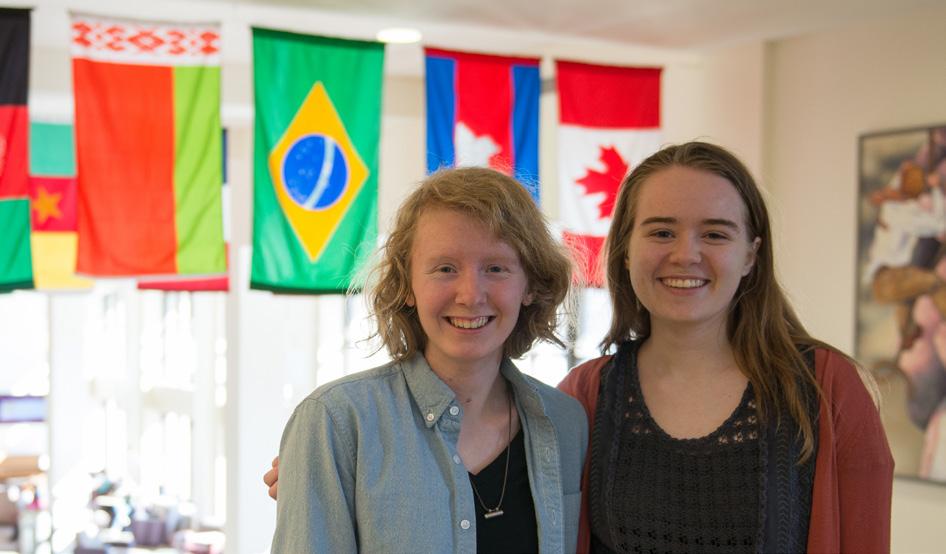
CONCORDIA SELECTS PEACE SCHOLARS
Alyssa Armstrong ’18, Rochester, Minn., and Sabina Beck ’19, St. Paul, Minn., were named Concordia’s 2018 Peace Scholars.
The Peace Scholars program, sponsored by Augsburg, Augustana, Luther, Pacific Lutheran, St. Olaf and Concordia, is designed to deepen students’ understanding of the central issues and theories regarding conflict, war and peace. Concordia’s Peace Scholars are underwritten by the Smaby Family Foundation.
Armstrong and Beck studied last summer for seven weeks in Norway at the Nansen Center for Peace and Dialogue in Lillehammer and at the University of Oslo International Summer School.
Armstrong, an environmental studies and English writing double major, sought to extend her many involvements in sustainability and increase her expertise in writing for social change. A global studies major, Beck used the experience to advance her interests and skills in the development of narrative imagination through story exchange to create a more empathetic world.
NEW NORM
The Center for Student Success is getting settled into its new space in the Normandy. Student support services and leadership groups will now have centralized space on the campus to call home.

FULBRIGHT SELECTS SCHAEFER FOR COLOMBIA
Rachel Schaefer ’18, Moorhead, was awarded an English Teaching Assistantship through the Fulbright U.S. Student Program and is working at the Universidad Nacional de Colombia, Manizales.
A Spanish and education double major, Schaefer studied in Spain for a semester. She also taught at a diverse, academically challenging school in Norway. Prior to her teaching assistantship, she traveled to Tanzania with Concordia Language Villages and the Singita Grumeti Fund to teach English to young students in northern Tanzania.
“After Colombia, I do not have any specific plans, but I would potentially like to serve in the Peace Corps or volunteer abroad for several more years,” Schaefer said. “Eventually, I would like to teach in an inner city area of the U.S., pursue further schooling and work as an education advocate for those who do not have easy access to education, potentially as a part of the United Nations.”
In just more than four years, Schaefer will have traveled to Norway, Rwanda, Spain, Tanzania and Colombia – influencing the affairs of the world along the way.
2 | concordia magazine news
CONCORDIA AWARDED ANDREW W. MELLON FOUNDATION GRANT

Concordia College was awarded a $1 million grant from The Andrew W. Mellon Foundation.
The grant was awarded to the college in honor of former Mellon Foundation president and Concordia College alumnus Dr. Earl Lewis ’78.
The grant is to be used for college projects that reflect Lewis’ leadership initiatives. Lewis is the chair of the Board of Regents, the college’s governing board, and has previously helped fund diversity scholarships along with alumna Fay Ferguson ’73.
“We are pleased to have this new funding to extend initiatives already begun by the college and are grateful for Dr. Lewis’ dedication to Concordia and to the Mellon Foundation,” said Dr. Eric Eliason, dean of the college and vice president for academic affairs. “Each of these projects will expand the college’s reach and benefit the entire campus community.”
The projects selected for the grant funds are intended to enhance faculty innovation, strengthen the college’s ability to include students from a wider range of backgrounds, and support the arts through the college’s partnership with the National Book Foundation.

HALL OF FAMERS INDUCTED
Concordia inducted six former student-athlete All-Americans into the Athletic Hall of Fame in September: women’s track and field athlete Laura Utke ’99, women’s golf MIAC medalist Jennifer (Kovash) Spitzner ’01, men’s hockey AllAmerican Bryan Howard ’01, dual-sport athlete Adam Strainer ’01 from men’s track and field and football, Mark Hankel ’01 from football, and women’s golf MIAC medalist Christie (Strecker) Nelson ’00.

THE JAKE GETS NEW VIDEO SCOREBOARD
The west end of Jake Christiansen Stadium received a major upgrade this fall with a new video scoreboard.
The new scoreboard structure is 50 feet wide from brick pillar to brick pillar and 44 feet high from the ground to the top of the Jake Christiansen Stadium sign. Inside the structure, there is a high definition video board that is 32 feet wide and 18 feet high.
“The scoreboard and sound system at The Jake needed updating,” head football coach Terry Horan said. “The new system is a huge boost for the game day experience as well as helping with recruiting.”
The $1 million scoreboard was made possible through the generous contributions of six donors. The principle donor for the new scoreboard was the Scott and Shelly (Offutt) ’84 Neal family. The Neals have close ties with the program because their sons, Logan ’11 and Griffin ’14, played for the Cobbers. Griffin was a three-time All-MIAC honoree who set school records for career passing yards and touchdown passes.
This is the third update to Jake Christiansen Stadium and Athletic Complex since 2010. The grass field was replaced with FieldTurf in 2010 and a new outdoor locker room complex was added in 2014.
WINTER 2019 | 3
news
AWARDS PRESENTED AT STATE OF THE COLLEGE
Prestigious Ole and Lucy Flaat Awards and a Reuel and Alma Wije Distinguished Professor Award were presented at the annual State of the College celebration. This year, the Inclusive Excellence Award was established to recognize outstanding work of a staff member who has creatively and innovatively strengthened the institution through initiatives that advance diversity and inclusion.
Ole and Lucy Flaat
Distinguished Teaching Award
Ron Twedt assistant professor of accounting
Ole and Lucy Flaat
Distinguished Advisor Award
Dr. Roy Hammerling chair and professor of religion
Ole and Lucy Flaat
Distinguished Service Award
Lance Anderson
lead groundskeeper for Concordia Language Villages in Bemidji, Minn.
Ole and Lucy Flaat
Inclusive Excellence Award
Mikal Kenfield director of Residence Life
Reuel and Alma Wije
Distinguished Professor Award
Dr. Joan Kopperud professor of English and director of integrative learning
The Flaat awards were endowed by Ole and Lucy Flaat, lifelong farmers in the Red River Valley. The Reuel and Alma Wije Professorship recognizes superior classroom teaching and significant service to the college and the church.

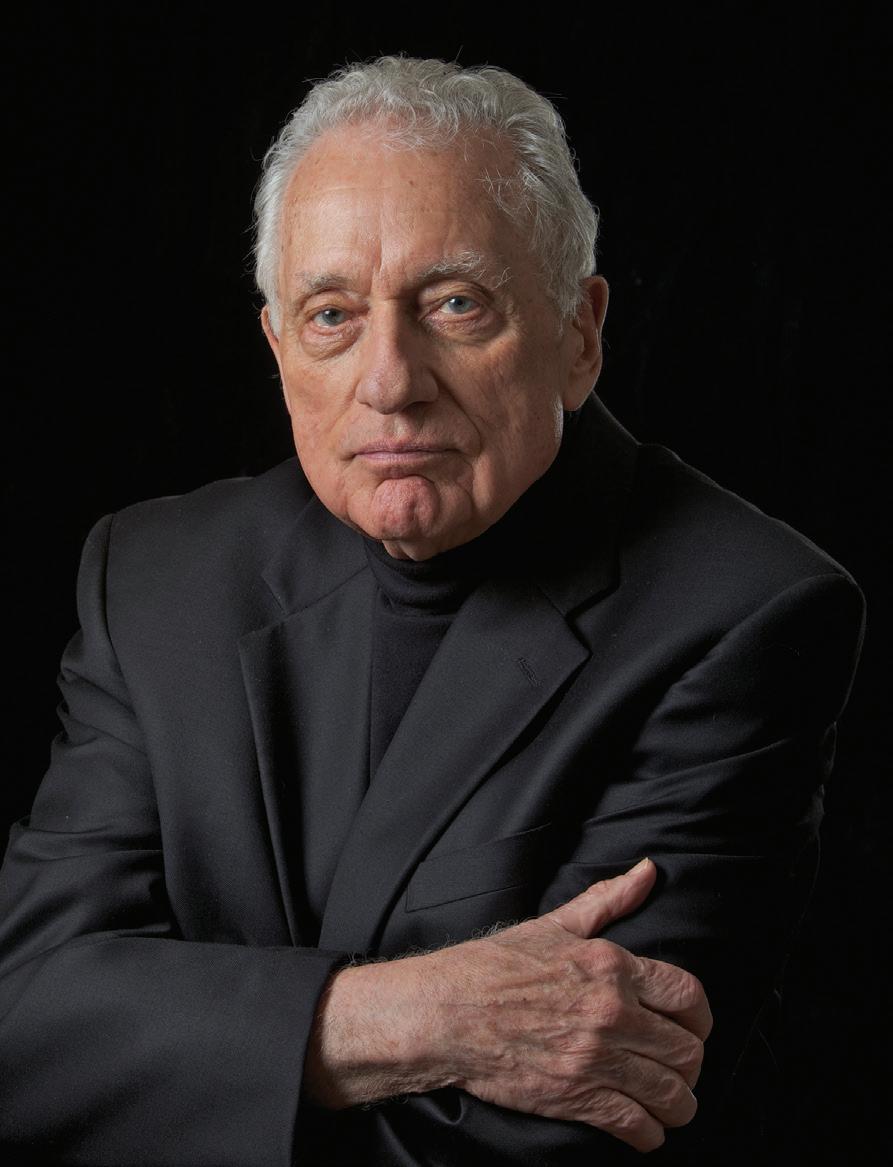
ALUMNUS RECEIVES NORTH DAKOTA AWARD
Former Secret Service agent and Concordia alumnus Clint Hill ’54 was named the recipient of the 44th Theodore Roosevelt Rough Rider Award in October.
Hill was a Secret Service agent from 1958 to 1975, serving five different presidents. He started on the presidential detail protecting President Eisenhower. He then served as the agent assigned to first lady Jacqueline Kennedy and was on duty walking next to the presidential limousine in Dallas when President John F. Kennedy was shot. One of the most famous images from that fateful day shows Hill jumping on the back of the vehicle as it sped away from the parade route.
Hill received Concordia’s Alumni Achievement Award in 2011 and has written three books about his time working for the Secret Service.
The Rough Rider Award was established in 1961 and is awarded to current or former North Dakotans who have achieved national recognition in their fields. Forty-three North Dakotans have received the award and their portraits are on display in the lower level of the Capitol building.
North Dakota Gov. Doug Burgum presented Hill with the award in November during a ceremony attended by more than 200 friends, family, and other well-wishers at the Lewis and Clark Interpretive Center in Hill’s hometown of Washburn.
4 | concordia magazine
news
Photo (l-r): Dr. Earl Lewis ’78, Dr. Roy Hammerling, Dr. Joan Kopperud, Mikal Kenfield, Ron Twedt and Dr. William Craft (not pictured: Lance Anderson)
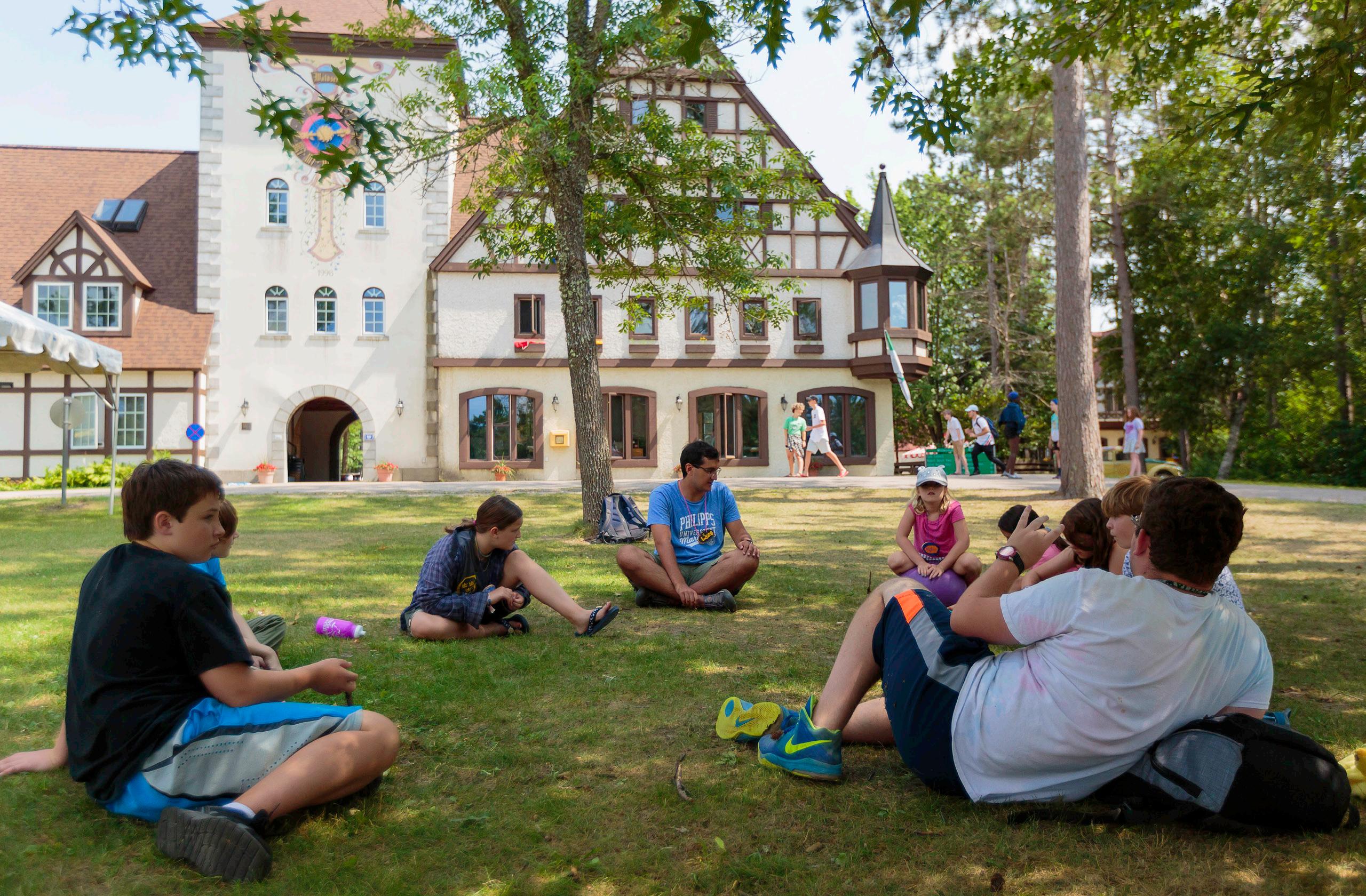
BUSINESS INNOVATION
LAB OPENS
Learning got more robust this year in Grant Center 117 with the Offutt School of Business Innovation Lab. The new space offers students the technology required for learning the latest computer science, data analytics, management information systems and software engineering concepts.
In addition to 24 high-powered PC workstations and Mac mini computers with 27inch, 4K monitors, the room boasts its own server rack with enterprise-level equipment for students to run simulations and experiments in a sandbox environment. The primary touch-screen display provides opportunities for innovative classroom activities that go beyond the capabilities of a traditional whiteboard, and each of the six workstation clusters also has its own display that can mirror the primary monitor or any cluster device.
Completed in summer 2018, the Offutt School of Business Innovation Lab was made possible through a gift from the late James Parke ’68.
NEVER FORGET: WALDSEE NAME TO SERVE AS EDUCATION FOR WWII HORRORS
The German Language Village, Waldsee, has educated thousands of young people and families for nearly 60 years. The Concordia Language Villages pedagogy emphasizes language and cultural immersion, always inextricably intertwined. In April 2018, the German Language Village staff learned an awful reality about the word “Waldsee” dating back to World War II. Jewish prisoners being transported from Greece and Hungry to the killing centers, such as Auschwitz, were told they were going to an idyllic destination called “Waldsee.” Nazi soldiers even went as far as to have prisoners write postcards to family members saying they were fine at a beautiful place called “Waldsee,” then the prisoners were killed.
After the horrific discovery associated with the name “Waldsee,” Concordia Language Villages formed an advisory committee of scholars, villager parents, museum directors, representatives of the German government, and experts on the Shoah and the Jewish community. After months of consultation that included reviewing some of the postcards that are now in an art exhibit, forums for parents, alumni and villagers, and connections to the mayors in the towns of Bad Waldsee and Waldsee in Germany, it was determined the German Language Village would keep its name. In so doing, this would serve as an educational tool for this part of history. Through programming, remembrance and awareness events, Concordia Language Villages will honor the people harmed by the use of this part of history so we never forget.
WINTER 2019 | 5
news

BUSSIE RELEASES NEW BOOK ON LOVE ACROSS DIFFERENCE
Dr. Jacqueline Bussie, professor of religion and director of the Forum on Faith and Life, released a new book in August titled “Love Without Limits: Jesus’ Radical Vision for Love with No Exceptions.” The book, published by Fortress Press, sold out online the first day of sales. In it, Bussie writes down-to-earth theology in the way she would speak with her students about it.
“I want to write like I teach and I teach through stories,” Bussie said.
These true stories are also theological truths, she said. Bussie describes the book of stories as both a memoir and a how-to guide “for love across difference in divided times.”
The book includes narratives of people who are important to Bussie who taught her to love bigger. The book hit a bump in the road when the original publisher asked Bussie to delete stories about people who are LGBTQ or Muslim. She refused and her contract was canceled. Through the power of social media, friends picked up on her plight for a new publisher and Fortress signed on. When not teaching, Bussie is on a book tour throughout the U.S.
POWER PLAYS: WHY GENDER MATTERS
The 2018 Faith, Reason and World Affairs Symposium examined the ways in which gender and power intersect with other forms of difference, including race, class, sexuality, religion and (dis)ability. For people in nations where laws prohibit gender discrimination, it may seem as though gender is no longer a pressing issue, but beliefs about gender differences continue to influence our daily lives.
Guest speakers were author and activist Rebecca Walker; Jackson Katz, co-founder of Mentors in Violence Prevention; and Debra Fitzpatrick, co-director of the Center on Women, Gender and Public Policy at the University of Minnesota.
RETIREES HONORED
Fourteen members of the faculty and staff retired in spring 2018. They have a combined total of 378 years of service to the college.
They are Laurie Bedford, Dining Services, 10 years; Kathryn Benson, Health Center, 50 years; Cherryl Braton, Business Office, 50 years; Donald Brummond, physics, 19 years; Cheryl Christianson, Health Center, 17 years; Renae Conyers, Business Office, 32 years; Steven Frank, Information Technology Services, 42 years; Dale Griffin, Dining Services, 22 years; David Grund, Facilities Management, 32 years; Mike Reese, Student Success and Retention, 10 years; the Rev. Dr. Ernest Simmons Jr., religion, 39 years; David Stalcup, Dining Services, 11 years; Dr. William Tomhave, mathematics, 33 years; and Bruce Vieweg, Information Technology Services, 11 years.

6 | concordia magazine
news
Photo (back): Dr. William Tomhave, the Rev. Dr. Ernest Simmons, Steve Frank; (middle): David Grund, Renae Conyers, Bruce Vieweg; (front): Cherryl Braton and Kathryn Benson
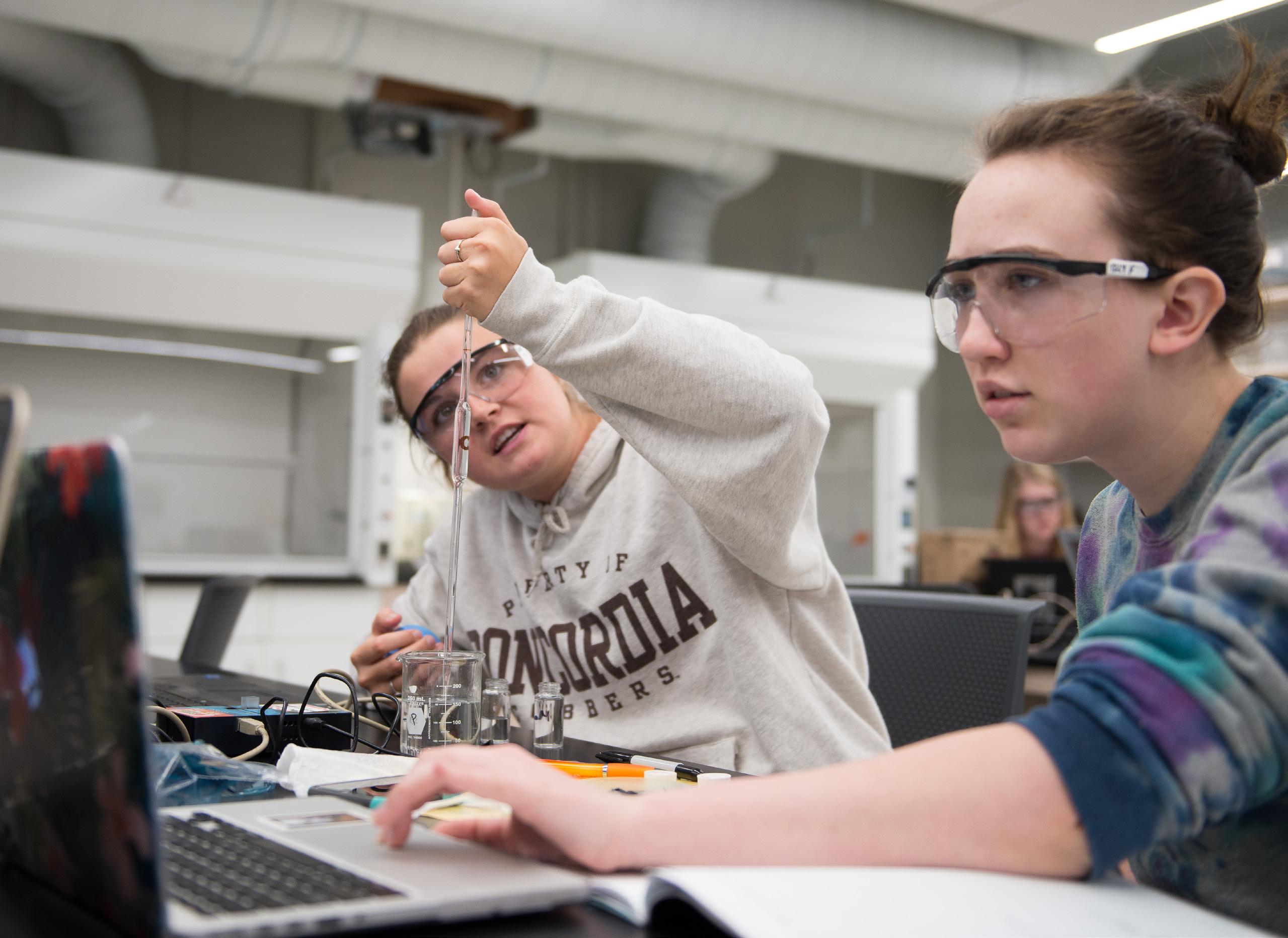
DR. VINCENT REUSCH PUBLISHES SHORT STORY COLLECTION
Dr. Vincent Reusch, associate professor of English, published a new short story collection that brings together love and loss, “The Mercurial Science of the Human Heart.”
“I held the title story in my head for probably two years,” Reusch said. “I would wake up in the middle of the night, thinking about it, piecing it together, very much like a puzzle. And then one night I had just had enough; I went downstairs to start it just to get something on the page.”
Though the stories all work with the idea of loss, Reusch wants people to know they also have humor and hope.
“Sometimes the humor may cause readers to feel a little uncomfortable, a bit like laughing during a funeral,” Reusch said. “But sometimes laughing during a funeral may be the most essential thing to do.”
A CENTURY OF CHEMISTRY
Concordia celebrated the century mark for its chemistry department in March in the new Integrated Science Center (ISC) with an allday gathering of former and current chemistry students, faculty, staff and friends of the department. The celebration, “A Century of Solutions,” commemorated the rich history of the department, from its humble beginnings in 1916 as a one-person department to the strong program it is today.
Much has changed in the last century. Chemistry professor Dr. Mark Jensen has been teaching at Concordia since 1997 and noted some of the changes since he first arrived more than 20 years ago.
“When I first started teaching in the mid1990s, email was just catching on, the internet was relatively new to most of us, and no one had a mobile phone,” Jensen said. “Now most of my day-to-day communication happens through email, many of our textbooks, lectures and assignments are delivered online, and students use their smartphones for everything from recording lectures to taking quizzes.”
Perhaps the biggest change the department has seen is the new building it calls home. The ISC was dedicated in fall 2017 and has created a buzz among students, faculty and staff. The $45 million project features dedicated labs for both research and teaching, and the space allows for more interactive and participatory learning. ◊
WINTER 2019 | 7 news

Concordia College Diversity Statement
Concordia College aspires to be a diverse community that affirms an abundance of identities, experiences, and perspectives in order to imagine, examine, and implement possibilities for individual and communal thriving. Critical thinking grounded in the liberal arts compels us to participate in intentional dialogue, careful selfreflection, and honest interactions about difference, power, and inequity. As responsible engagement in the world calls us to recognize worlds that are familiar or unfamiliar, visible or less visible, Concordia will act to increase and support diversity in all areas of college life.
adopted 2018
8 | concordia magazine
BROADENING THE CONCORDIA STORY
BECOMING INTENTIONAL ABOUT DIVERSITY
BY AMY E. KELLY
During the 2016 State of the College, President William J. Craft boldly stated this goal:
“As an American liberal arts college founded by immigrants, as a college of the church, Concordia will seek out, include, and honor a greater diversity of peoples and ideas, knowing that such action will change campus culture, ways of learning, and responsible engagement in the world.”
Knowing that this new direction would alter the current campus culture was invigorating for some and anxiety producing for others. Was now the right time to embark on such a change? The administration and Board or Regents gave a resounding, “Yes.”
The reasons for working to diversify are multilayered: new people and ideas invigorate students’ learning and faculty teaching. Creativity, innovation and thought processes flourish when populations are more diverse. Another reason was demographics. Populations of racially and ethnically diverse groups are increasing throughout the United States. In order to thrive, Concordia needs to be more inclusive to these groups. Thus, it became a goal within the college’s Strategic Plan and
set in motion a diversity process that is still taking shape.
Work started with a Diversity Action Team in 2016 that gave voice to people’s perceptions of the treatment and experience of non-majority groups on campus. The group gathered some baseline knowledge and worked to write a statement on diversity. Their work was taken up more formally by the President’s Diversity Council, a group appointed by the president with membership from faculty, staff and students. The council finished the Diversity Statement, an aspirational declaration for the work and change that needs to happen on campus.
While it was being crafted, the college also hired its first chief diversity officer in August 2017 and established the Office of Diversity. Student Government Association reorganized its structure to include a dedicated group called the Diversity, Equity and Inclusion Commission. These three bodies, the Office of Diversity, DEIC and the President’s Diversity Council, are the working groups forging forward with the Diversity Initiative. Understanding the work of each of these areas gives us a snapshot of where we are going with diversity at Concordia and how progress can still be a steep climb.
WINTER 2019 | 9

The Office of Diversity
Chief Diversity Officer Dr. Edward Antonio started Concordia’s Office of Diversity in summer 2017. Antonio says he stepped into an institution rich with history, “a history that was predominantly white.” What he didn’t expect was a faculty and staff eager to get the diversity initiative moving.
“Upon arrival, I encountered 127 years of impatience. Everyone wanted me to move quickly to create a strategic plan, to come up with programs and to increase the diversity of students, faculty and staff,” Antonio says. “There is a saying in my culture, ‘Do not try to run before you’ve learned to walk.’ We need to go slow in order to go fast.” Antonio says he is still attempting to drive a balance between making progress and learning about Concordia and laying foundations so progress sticks.
An observation early on in Antonio’s time at the college was the local community makeup. The Fargo-Moorhead area was becoming more diverse, but it wasn’t reflected in the demographics of local students enrolling at Concordia. With collaboration from colleagues, a plan was brought to the Board of Regents and the board approved funding for Community Access Scholarships, full-tuition scholarships for diverse local students.
“Because the Board of Regents took that action, that told me my decision to come here was right and that this college means business,” Antonio says.
The Community Access Scholarship was awarded to six students for fall 2018, but 15 students from that prospective group of students ended up attending. Those early successes were met with excitement and concern. Was the college ready to adequately support these students?
Antonio says the purpose of his office is to support the campus in the endeavor of helping every student thrive. Some of the first steps have been workshops for faculty, microaggression training for various campus groups, and President Craft recently appointed a Bias Incident Response Team to evaluate concerns about potential bias on campus. Work is just beginning to move the King Intercultural Center from Park Region Hall into the Wall Lounge in the Knutson Campus Center. The new location will serve students better as a gathering space in a prominent, central place on campus.
Glory Kom Petnkeu ’19, the lead commissioner for the DEIC, says the new location sends a message that minoritized students should also have space in the heart of campus.
Looking to the future, Antonio says he plans to work at balancing the urgency of the needs in the moment with the needs for strategic diligence. He also wants to see change happen through engagement between the dominant groups and those who feel in the margins.
“Engaging each other in conversation is important. The solution is dialogue,” Antonio says. “It’s inviting people into the process of transformation.”
Diversity, Equity and Inclusion Commission
Nestled between the Campus Ministry Commission and the Campus Events Commission in the Parke Student Leadership Center, the Diversity, Equity and Inclusion Commission has comfortable yet functional space for students to meet. Holding space for those who don’t necessarily identify with a majority group is extremely important, Kom Petnkeu says.
The DEIC is doing much more than offering space. In its second year as an official commission of SGA, the group is hosting events, especially ones in which people can talk through complex issues of equity and inclusion. The commission is building foundational events that will help future commissioners expand the group’s offerings.
“We don’t have dozens of years of being a commission,” Kom Petnkeu says. “We are new and still have to learn and grow. Our goal is to provide a commission that celebrates everyone’s stories.”
The commission’s advisor, Amena Chaudhry, who conceived the idea for the new commission in partnership with the director of student engagement, echoes that sentiment. She knows how much the commissioners have learned in just the first semester and believes the new commission offers great leadership opportunities.
“I wasn’t seeing minoritized students in leadership roles,” Chaudhry says. “This is a way to grow in leadership and event planning with a cultural emphasis.”
10 | concordia magazine
The commission works on both small and largescale events. It plans the Martin Luther King Jr. Day event and assists with the Tri-College Powwow. There are also several smaller informal events that the group leads. Chaudhry says the beauty of student groups is they can pull together events with agility because their fellow students prefer relevance to polish. An example is the Spill the Tea event, which sometimes has a specific topic that has come up that week and other times is more for socializing and discussion. Another benefit as an official commission of SGA is access to funds for programming.
“They have the ability to impact the student experience,” Chaudhry says. “For instance, a poverty simulation costs money to bring to campus, but they have the choice to use funding for that project.”
Kom Petnkeu has been happy with the turnout for the events, but a big challenge is having white students know they are welcome and encouraged to attend the DEIC events. She believes that the DEIC is also a good recruitment tool so the college can talk about a place and an organization that is working to elevate the cultures and leadership of students of color and other marginalized students.
“Just letting students of color know something is being started and someone is making some noise, that’s an accomplishment,” Kom Petnkeu says.
President’s Diversity Council
The only group to officially have voices from all areas of the college, the President’s Diversity Council is working to keep an eye toward the pulse and temperature of the campus. Council member Dr. Fanny Roncal Ramírez, associate professor of Spanish and Hispanic studies, says a complicating factor for the council is determining the diversity scope.
“What kind of diversity do we want Concordia to have – gender, cultural, class, ethnic?” she says, noting cultural diversity has been much of the focus thus far. “What are we doing to form a community where everyone is valued?”
Roncal Ramírez is pleased that the Diversity Statement now exists and says a key to the council’s goals will be working with the dominant group to create greater understanding. Noting that college is tough for students in both the minoritized group and the dominant
group, she believes education about power is important, especially for those in the dominant group who may feel powerless and may not understand the built-in power of being white. This is difficult work, Roncal Ramírez says, because self-awareness often comes with guilt and shame, which is not the goal as she wants all students to feel valued.
One way to create opportunity for cultural understanding is through a concept Roncal Ramírez calls a third space. If you and I are from two different cultures, I can’t join your space and completely understand you nor can you do the inverse. What’s needed is a third space where neither culture is dominant in that setting.
“It is a place for us each to give the best of us and have positive human interactions,” she says.
History professor and Diversity Council Chair Dr. Richard Chapman says the Diversity Statement is a first step but one the college hasn’t “lived in” yet.
“I get the sense that we might too glibly and easily pat ourselves on the back right now, though I’m not sure we are truly primed to participate in a transformed culture,” Chapman says.
Chapman has researched the upsurge of black students on campus in the late 1960s and 1970s, a time Concordia was by far the most racially diverse. Through various obstacles, the numbers dropped off.
“I fear we learned almost nothing from that time. The keepers of that memory are few and far between. We need to make more public the idea that this was done with remarkable success and I think that we can do it again,” he says.
His biggest concern this time around is that we won’t take a deeper dive or when the risk seems large or costly we pull off the gas pedal too quickly. Chapman thinks not doing diversity work would be a detriment to all of our students.
“We cannot desist. If we believe this is the right thing to do then we need to stay the course,” Chapman says with conviction. “We are going to have to find persuasive ways to incorporate diverse learning experientially, in events, in classes – across the places we learn. Diversity excellence at the core is in the best interest of all of our students. They will be better people because of it.” ◊

WINTER 2019 | 11



LEARNING BY DOING
APPLYING THE LIBERAL ARTS
By Eric Lillehaugen
Across the country, traditional four-year higher education institutions face similar challenges: plateauing or decreasing enrollment and skepticism toward the notion that an increasingly expensive college or university education is a wise investment.
Trends show that many students today are seeking practical skills and straightforward paths to employment though shorter technical programs. Contrast that with the staples of a traditional four-year liberal arts education and the issue becomes evident: the broader, less specialized learning and basis in critical thinking at the core of the liberal arts seem to be at odds with the demands of the market. Critics might call the approach old fashioned.
Far from outdated, however, publications like Fast Company and Business Insider routinely turn to a liberal arts education when forecasting the needs of a technology-driven, global, future workforce. In a world primed for the next technological revolution driven by automation, the demand for problemsolvers and critical thinkers has nowhere to go but up.
So how do we best prepare students for a future where critical thinking and complex reasoning will be more valuable than ever while serving today’s demand for immediate results and concrete cost/benefit comparisons? If the value of traditional higher education is in question, what is Concordia’s answer?
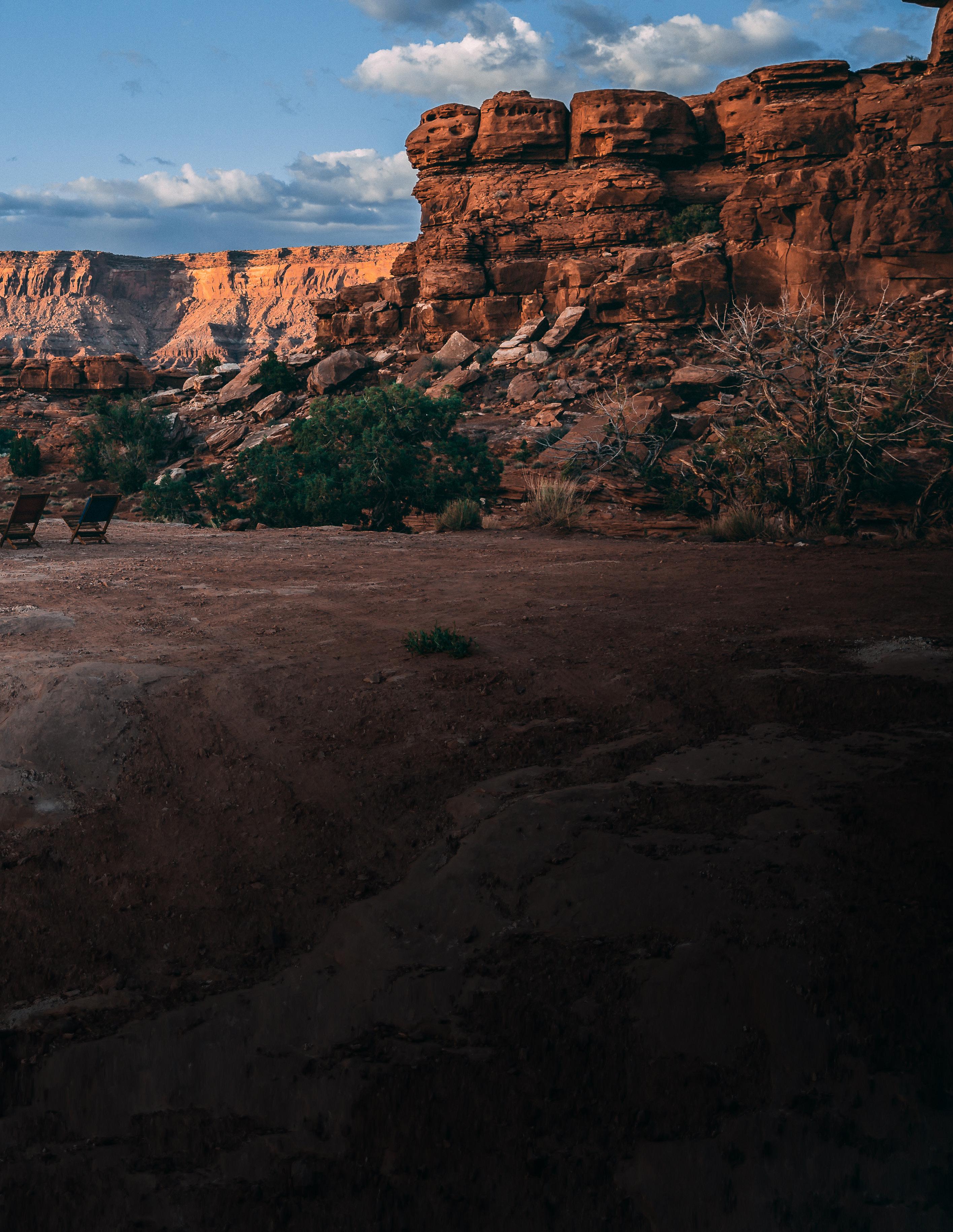
Integrative Learning
In 2014, development began on a revamped curriculum based on integrative learning – a 21stcentury approach to educating students to become responsibly engaged in the world. Rather than a comprehensive overhaul, however, integrative learning could be described as a guiding model that builds on the strengths of Concordia’s liberal arts approach while developing the results-oriented practical skills and competencies demanded by today’s value-conscious students.
Added to the curriculum in fall 2017, a Pivotal Experience in Applied Knowledge (PEAK) represents the most concrete expression of Concordia’s broader commitment to integrative learning. These opportunities combine the academic classroom experience with practical ones that prepare students for the complex, rapidly changing world where they will live, work, and serve. In short, PEAKs get students out of the classroom to engage with real-world problems working alongside the people who understand those problems best. And every Concordia student will complete two of these PEAKs prior to graduation.
Mentored by faculty and staff, students have a wealth of opportunities to find the perfect fit with PEAKs that will define their Concordia experience. Many academic courses, study away experiences, internships, research, and cocurricular experiences have been designed around PEAK criteria with additional opportunities for students to propose their own individual PEAKs.
FIVE CRITERIA OF INTEGRATIVE LEARNING Venture beyond the classroom
Encounter and work alongside persons or groups wrestling with complex situations, problems, questions or challenges
Construct meaningful, interdisciplinary responses to these encounters, taking seriously multiple perspectives
Discover questions, perspectives, and problems not necessarily scripted in a course syllabus and work through ambiguity, frustration, and disequilibrium
Sharpen and apply skills and competencies that flow out of a liberal arts education and are relevant to future employment
WINTER 2019 | 13
Photo: Dan Pfeifer ’18

What does a PEAK look like?
For students in assistant professor of philosophy Dr. Tess Varner and assistant professor of photography Chris Mortenson’s interdisciplinary Nature and Culture course, PEAK looks like stunning vistas and nights spent communing around a campfire under a starry sky.
This PEAK, a monthlong portal seminar (formerly known as a May Seminar), saw 17 students explore the landscape of the American West, traveling more than 5,000 miles by van while tent camping in eight national parks. Fully immersed in the subject at hand, students explored digital photography – both skills and history of landscape photography in America –and nature writing as a particular form of publicly engaged philosophy.
Mortenson believes the format for his course is a natural fit for PEAK.
“The very nature of exploring the country by road trip automatically signs you up for wrestling with complex issues and invites interaction with others who are not normally an active part of campus conversations,” Mortenson says.
Varner agrees, adding that the strength of PEAK is in offering students the chance to get out of the traditional classroom, engage with communities that have a real stake in the subject at hand, and make deep connections between the literature and skills they explore in class and the hands-on experiences of active engagement in the world.
“In the case of this class, it made a world of difference to read Edward Abbey in the places where Edward Abbey was writing,” Varner says. “To read about tensions of land use that Terry Tempest Williams explores in those disputed places themselves, to talk to people whose lives are directly impacted by those tensions, and to touch the contested soil itself.”
Connecting experience to academic knowledge in this way simply wouldn’t be possible in a traditional classroom setting alone. Through PEAK opportunities, students are being asked to grow and connect in new, more meaningful ways that will better prepare them for life after Concordia.
14 | concordia magazine
Photo: Dan Pfeifer ’18
Community Connections
For students in education professor Dr. Barb Witteman’s first-year PEAK, Hungry!, those meaningful connections are made at home by studying hunger in the Fargo-Moorhead area and working with fourth-grade students at Washington Elementary in Fargo.
In Witteman’s course, community engagement and the application of classroom theory to realworld problems are at the core of the experience. From bagging dry beans for the Emergency Food Pantry to teaching their fourth-grade buddies how to research a topic and present their work, Witteman’s class is taking steps toward understanding and addressing a pressing issue: hunger right here in our community.
Witteman sees the effect this hands-on approach has in developing her students as leaders and lifelong learners and feels the value can’t be overstated even though most of her students in this first-year class are not majoring in education.
“I love the integrative, hands-on, minds-on approach to education and this course does all of this,” Witteman says. “My students are highly engaged and excited to work with the fourthgraders and every student learns that everyone is a teacher no matter what academic field you pursue.”
That philosophy of engagement resonated strongly with biology major Brandon Ciak ’21. His experience with Hungry! – his first PEAK at Concordia – has, in some ways, set the tone for the rest of his academic experience.
“I strongly feel that PEAK courses, this one in particular, provide experiences that are valuable to each student’s overall experience at Concordia,” Ciak says. “Not once did this course feel as if I was going through a mundane process of doing homework or studying in order to do well in the class.”
The opportunity to take his Concordia experience off campus and directly impact the lives of others, especially young students, was meaningful to Ciak. The connection to the college’s mission – becoming responsibly engaged in the world (or BREW) – felt genuine.

“BREW inspires students to serve the world’s greatest needs,” Ciak says. “Participating firsthand in this ‘BREWing’ has added an additional aspect to my education. This has helped me discover how to become a more well-rounded student who will be capable of engaging with the world.”
That may be PEAK’s greatest strength. At their core, these experiences are an extension of what a Concordia education has always been – a more fully realized and codified system for recognizing the unique ways Concordia students are equipped to grapple with the realworld challenges they’ll face after graduation.
Dr. Joan Kopperud, English professor and director of integrative learning at Concordia, knows better than anyone that the college’s commitment to integrative learning is at once both a reinvigoration of the college’s curriculum and an affirmation that there will always be value in the liberal arts.
“PEAK isn’t just a graduation box to check,” Kopperud says. “Rather, PEAK challenges the entire campus community to think about how we educate our students so they are prepared to go into society not only thoughtful and informed through traditional classroom learning, but also prepared through real-world, integrated learning to handle complex problems in the workplace and communities.”
Integrative learning and PEAK may not answer every question in the complex equation that makes up the college search for today’s students. But in its genuine approach to preparing our students both in the practical ways they want and the broader ways they may not yet know they need, integrative learning helps bring the liberal arts into the 21st century. ◊

2018-19 ENROLLMENT UPDATE
As we welcome students to campus each fall, we recognize the important role of alumni, parents, and friends of the college in promoting Concordia to prospective students.

FALL FIRST-YEAR CLASS
This fall’s class of 597 freshmen was 5 percent larger than last year’s and 9 percent higher than fall 2016. Of the 17 schools in the Minnesota Private College Council, Concordia’s first-year class ranks the sixth largest. Only St. Thomas, St. Olaf, Bethel, Gustavus Adolphus and Macalester had larger classes of first-year students this fall.

Most popular academic programs: business, biology, chemistry, nursing and psychology
Involvement in cocurricular activities continues to be a strong reason students choose to enroll at Concordia.
TOP 10 HIGH SCHOOLS SENDING THE MOST FIRST-YEAR STUDENTS
- Moorhead
- Davies, Fargo
- Brainerd
- Alexandria
- Dilworth-Glyndon-Felton
- Fargo South
- Sheyenne, West Fargo
- St. Michael-Albertville
- Breckenridge
- Willmar
More than 50 percent expressed an intention to participate in one of Concordia’s music and fine arts programs.
More than 40 percent reported an intention to play Division III athletics.
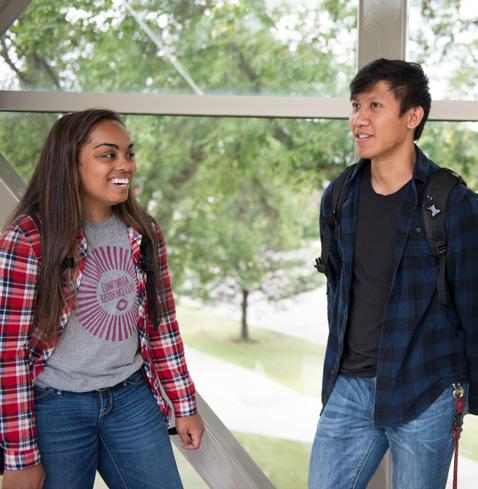
35 U.S. STATES

20 COUNTRIES

68% from MINNESOTA
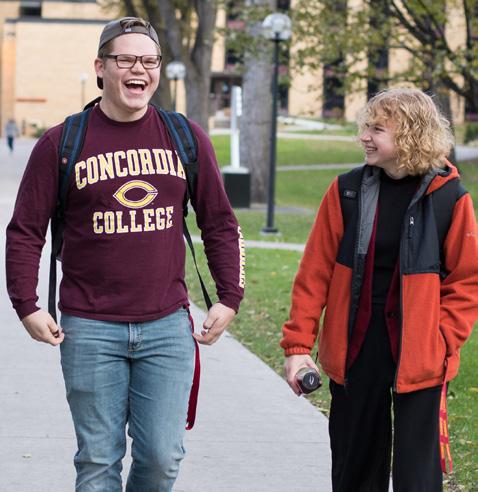
18% from NORTH DAKOTA
16 | concordia magazine

Transfer Students
This fall, 28 transfer students arrived on campus (compared to 44 new transfers last year). The largest sources of new transfer students were from North Dakota State University, Minnesota State Community and Technical College (M State), Central Lakes College, University of Minnesota Crookston, University of Alaska Fairbanks and Riverland Community College.
International Students
A total of 30 new international students (27 first-year students and three transfers) enrolled at Concordia this fall. These students provide a rich diversity of culture, faith and worldview to the overall learning environment at the college. The top-sending countries include Nepal, Canada, China, Ethiopia, Mongolia and Vietnam.
Fall 2018 Enrollment
A total of 2,129 undergraduate and graduate students enrolled for fall 2018 (compared to 2,059 total students in fall 2017). The increase is, in part, a product of larger freshmen classes the last two years.
Fall 2019 Admission CampaigN
The recruitment plan for fall 2019 is well underway. The enrollment targets for the upcoming year include a freshman class of 585 and a new transfer class of 50 students.
International Scholarships
International Excellence Scholarship
All international students admitted to Concordia receive an International Excellence Scholarship. Amounts vary but begin at $17,000 per year and are renewable.
You Are Welcome Here Scholarship
In fall 2019, Concordia is launching the You Are Welcome Here Scholarship, which will offer two annual, renewable scholarships that will cover a minimum of 50 percent of recipients’ tuition. These scholarships support incoming international students who are committed to furthering the #YouAreWelcomeHere message through intercultural exchange that bridges divides at their future campuses and beyond.
ELCA International Women Leaders Scholarship
Women from around the world are empowered by this scholarship program to earn their degree in the United States. Two students with this scholarship are currently at Concordia, one from Cameroon and one from India. ◊
We could not reach our enrollment goals without your help and support. If you know a high school student who would thrive as a Cobber, please complete an online referral form: ConcordiaCollege.edu/refer
WINTER 2019 | 17
PARTNERSHIP in port-au-prince
by kayla stenstrom


hen Concordia students arrived at the TeacHaiti School of Hope in May 2018, its massive gates sealed off the sound of people selling wares and small vehicles racing down the potholed streets of Port-au-Prince. The chaotic noise was replaced by that of children playing, songs slipping from classroom windows and the busy hum of lunch being prepared. This was the vision of Miquette Denie McMahon ’06 made real – a place where education is changing the course of poor health and poverty in her community.
In 2007, nursing graduate McMahon founded the nonprofit organization TeacHaiti to educate Haitian children. Unlike the free public education offered in the U.S., Haitian families must pay for their children’s schooling, which is often not possible. In response to dismal literacy rates and the destruction from the 2010 earthquake, McMahon raised funds in the U.S. to open a school and primary care clinic in Port-au-Prince, along with a second school in her hometown of SaintMichel. McMahon received the 2016 Sent Forth Award for her transformative work and shared her story at Commencement in May 2017.
Seeking multidisciplinary study abroad opportunities for students, Dr. Per Anderson, associate dean for global learning, traveled to Haiti with nursing faculty Dr. Jean Bokinskie and Dr. Polly Kloster in August 2017 to conduct a risk management assessment. During the visit, McMahon, a former advisee of Kloster’s, expressed TeacHaiti’s desire for child health education on basic hygiene and communicable diseases, along with classroom French language instruction.
In a serendipitous encounter at the compound where they stayed, the Concordia group met Marion Nonglaton, country director for Pure Water for the World in Haiti, which sets up water biofiltration systems and educates residents on waterborne diseases in rural villages. Amid discussing related goals, a partnership began.
Upon return to Minnesota, Kloster enlisted Dr. Gay Rawson, professor of French. The two had traveled together since 2004 – primarily in Vietnam and Cambodia (also Francophone countries), where they facilitated dental and eye exams and health education programs.
In light of meeting Nonglaton and an opportunity closer to the U.S., they envisioned students teaching infection control and general health in the same rural Haitian communities where Pure Water provides access to safe drinking water and prevention of waterborne diseases.
“Whatever we were going to do in Haiti, it was going to involve service, which is not to say that we would go in and do for but would go and do with them.”
– Dr. Polly Kloster
“It’s not to rescue; it’s standing and working together, helping us understand what’s going on with their culture.”
WINTER 2019 | 19

Kloster and Rawson launched an independent study in spring 2018 with students in the French and nursing programs. Their students developed education modules on health topics requested by TeacHaiti and Pure Water and outlined the time, equipment and staff needed to teach them. They also made isolation precaution signage, translated into French, for their facilities. They developed culturally and age-appropriate curriculum on handwashing, oral and body hygiene, and practiced their lessons with preschoolers at Cobber Kids.
In May 2018, 12 French and nursing students went to Haiti with Kloster, Bokinskie and Rawson to pilot their education program. Using donated materials they brought with (such as a giant toothbrush and model of a mouth), nursing students demonstrated health practices to children and taught hygiene-related games and songs while French students interpreted. Glitter was used in the hand-washing demonstrations as a visual cue of dirt removal and Pure Water for the World staff observed, offering tips on the teaching method.
Meanwhile, Kloster and her students administered immunizations and took vitals at the TeacHaiti clinic where McMahon’s brother, Dr. Isaac Denie, serves as the primary care physician. Brought in by families and nearby orphanages, the young patients were able to establish health records for the first time with the international director of health in Haiti. Sarah Quatier ’18 also provided instructions for CPR and first aid to healthcare providers, using manikins brought from the U.S. and left with TeacHaiti.
“CPR is not widely taught in Haiti or a common skill, so it was interesting to teach a group that was starting with minimal knowledge on the subject,” Quatier says. “It’s rewarding to know that this session has the potential to make a real, lasting impact. The French students gave me firsthand experience in working alongside interpreters,
which we use frequently in our Fargo hospital and are an incredibly valuable resource in connecting with people and sharing information.”
Experiences like this opened up questions for the participants: In the U.S., you initiate certain steps until help arrives, but what happens when you are the help – when one ambulance pushes through streets where it’s not a law to make room and arrives only for those who have insurance? What are the ethics involved in care without a defibrillator and advanced life support?
Each night, the Concordia group discussed such questions and kept reflective journals. They learned that their sessions needed adjustments, whether to minimize the water used in hand-washing or to choose a quieter setting than the crowded outdoor area where more Haitian students than they had designed the curriculum for wanted to participate. They also realized they had no trouble communicating with Creole speakers, who understood French when heard but some of whom couldn’t read and write it.
These cultural dimensions added richness and complexity to the team’s efforts. Samantha Smallarz ’19 was thankful for the opportunity to do hands-on work in her field of study and see an immediate impact.
“We tackled obstacles such as limited vocabulary, lack of supplies and short-notice plan changes,” she says. “It was powerful to see our own strengths come together as we overcame language barriers to provide healthcare, education and comradery for the people we worked with.”
The most poignant experiences for the Concordia students involved visiting a market, chapel service and metalworking factory. They shopped with three families of different economic levels, watching as they made choices between coal or food, water or household supplies.
20 | concordia magazine
“We didn’t just witness Haitian faith and love but were part of that journey,” Rawson says of attending chapel. “In an open-air structure with no walls, we felt more welcome than we ever have at church.”
The same week, the group walked through a metalworking factory that sells cut oil drums at an art shop in McMahon’s school. Among immense piles of dirt and garbage, shards of glass and metal, tangled extension cords and wandering roosters, barefoot men without protective eyewear cut metal while watching a TV strapped to a tree with bungee cords. When asked to identify visible health hazards, Concordia students suggested proper equipment, but Kloster reminded them that basic needs take precedence over a healthy work environment. After all, why would one care about safety methods or environmental impact when food and water are immediate concerns?
Questions like these stirred in their minds as they returned to campus and began dictating the plan for the academic year. Students in Rawson’s Caribbean/South America perspectives course and Kloster’s Community Health Nursing global perspectives course are preparing to conduct focus groups in Haiti. Instead of developing new curriculum, they are focusing on the significance of Haitian health issues and what can be done to address them. Though in separate classes, the French and nursing students meet regularly and convened for a global health forum at the end of fall semester.
Students will go to Haiti in May 2019 to conduct focus groups, screen Haitians for high blood pressure and diabetes, reteach CPR, conduct more nutrition and health checks, and host a World Hand Hygiene Day with Pure Water for the World at McMahon’s school. Pure Water will offer a course on menstrual health to more than 200 female students at no charge to TeacHaiti in exchange for translated health educational materials created by Concordia students. At the close of World Hand Hygiene Day, Haitian students will come up with a skit, a popular recreation in Haitian culture, to demonstrate their understanding of the objectives.
Kloster and Rawson want their students to see the big picture of public health both in Haiti and the U.S. – to assess the existing problems, the policies in place to deal with them, and the laws that ensure the policies are met and enforced for the greater good.
“We know that we can’t pick up what we do here and put it in their environment,” Kloster says. “Our nursing students know that patients’ inability to follow recommendations is not noncompliance on their part but our own noncompliance as healthcare providers for not understanding their understanding of the issue – that’s the starting point. It’s always about empowering the person.” ◊




WINTER 2019 | 21
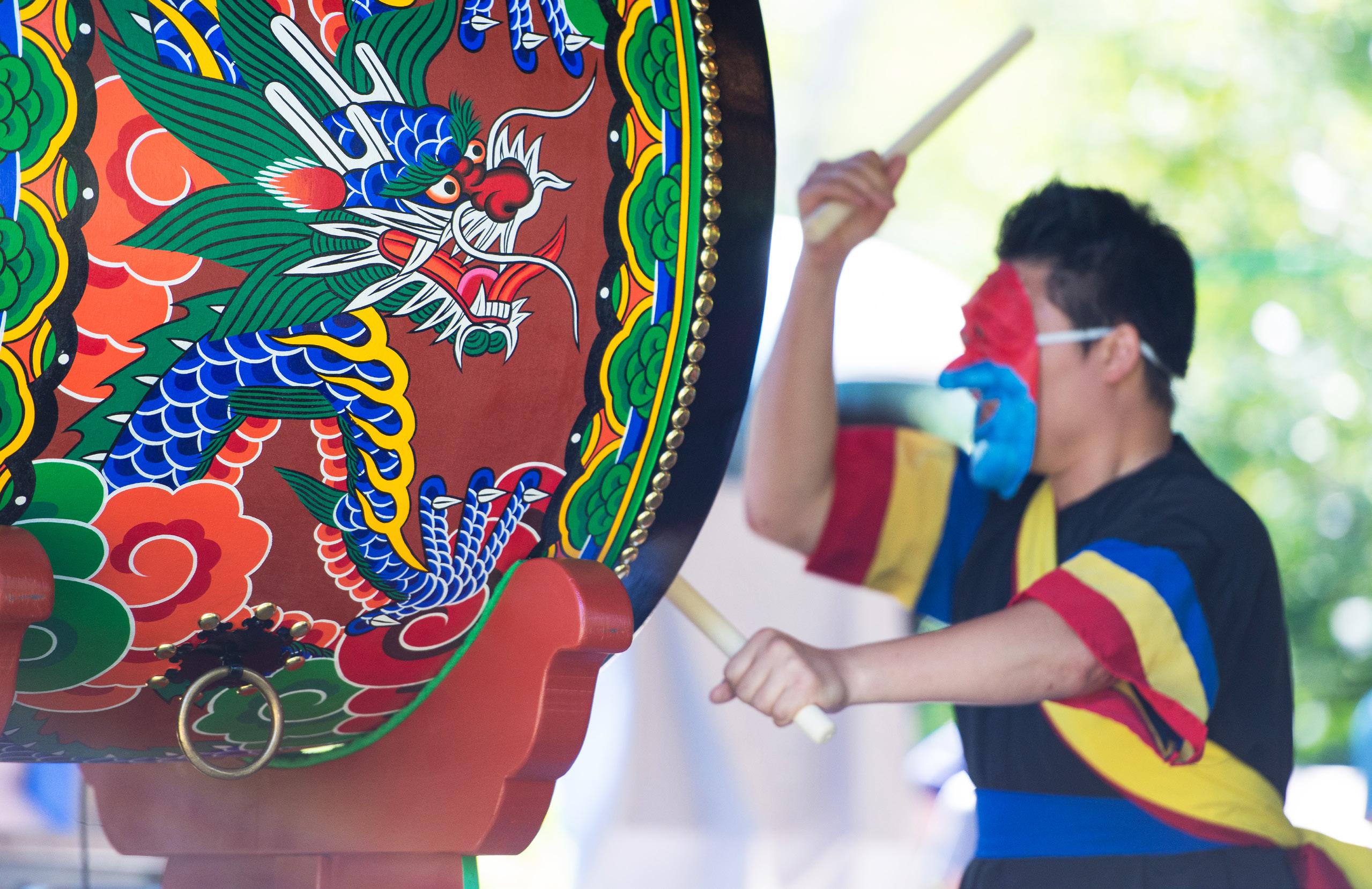
A HEARTFELT GIFT LEADS TO A SITE FOR KOREAN
by amy e. kelly
he Korean Language Village, Sup sogŭi Hosu, received an amazing gift for its 20th anniversary in summer 2018 – $5 million to build a culturally authentic site on Turtle River Lake near Bemidji, Minn.
The gift is from luxury handbag maker Kenny Park and his wife, Simone. Kenny Park is the CEO of Simone Corp., which makes handbags for brands such as Michael Kors, Marc Jacobs and Coach. It is the largest designer and producer of women’s luxury handbags in the world and the connection between its CEO and Concordia Language Villages is a story of someone putting his money where his heart is.
Park learned about Concordia Language Villages 10 years ago when the founding dean of the Korean Language Village, Dr. Ross King, did an interview for a radio station
in Seoul. Park heard the interview and King’s message that Koreans should invest in others around the world who are learning their language.
“Kenny Park asked his assistant to track down this person on the radio,” said Concordia Language Villages Executive Director Christine Schulze, “and that is how the relationship began, fostering 10 years of scholarships and program development grants from the Simone Corporation to Sup sogŭi Hosu.”
Park wants to expand the teaching of Korean language and culture beyond Korea and believes that Concordia Language Villages is one of the best answers to make that happen. Park is also intent on assisting young people to become better prepared for the world.
22 | concordia magazine

“I believe that one of the best gifts for young people is providing access and motivation for them to learn and experience global cultures,” Park said. “I consider the Korean Language Village to be a perfect model of how best to create global citizens.”
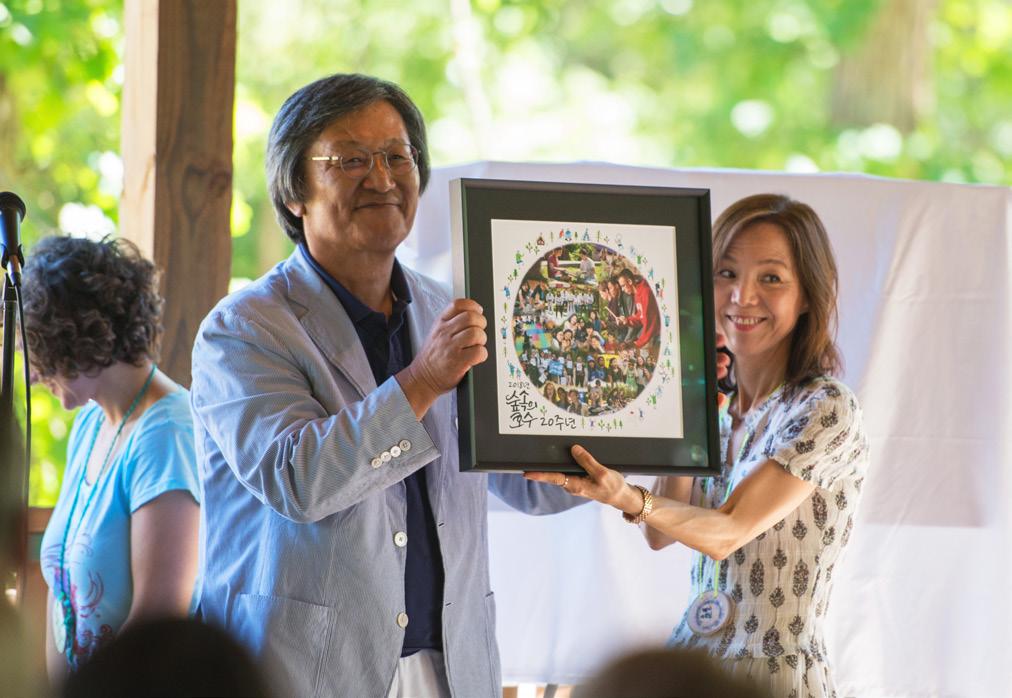
Kenny and Simone Park were honored for their gift at a celebration event during International Day last summer. Initial plans for the Village, the eighth Language Village with a permanent site and the first Asian Language Village to be built on an 875-acre tract of land on Turtle River, were unveiled at the ceremony. Archigroup MA, the design architecture firm, is based in Seoul. They invited representatives of the Minnesota-based architectural team LHB and Concordia Language Villages Director of Operations Warren Schulze to Korea this past September to gain more insight into the architectural elements that will blend the past and present of Korean culture.
“The Korean Language Village will have a modern feel to it, but the layout of the buildings are soundly based in Korean tradition,” Warren Schulze said. “On our architectural tour
we visited Byeongsan Seowon, a Confucian school built in 1572. Sup sogŭi Hosu is essentially modeled after this ancient school.”
As with all Village sites, there is careful planning to make the language immersion experience feel authentic through the students’ surroundings. Every detail matters when trying to make a villager feel they have entered a Korean setting when arriving at Concordia Language Villages.
“Traditional Hanok buildings have distinctive roof features that are uniquely Korean,” Warren Schulze said. “Our plan calls for a traditional Hanok pavilion, an open-air outdoor structure. The handcrafted pillars and roof structure will need to be made in Korea and then assembled by the same craftsmen in Bemidji.”
Phase one of the project is scheduled for completion in summer 2020. ◊
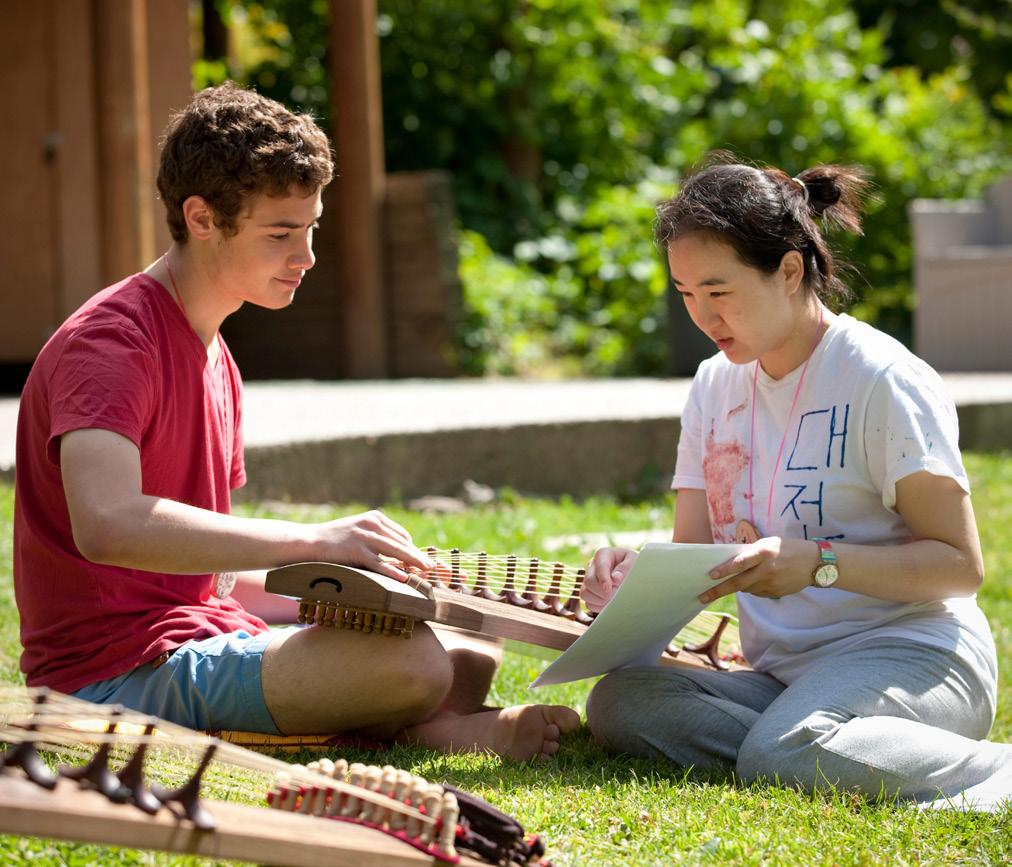
WINTER 2019 | 23
A ceremonial groundbreaking for an authentic Korean Language Village site took place at the 20-year celebration of Sup sogui Hosu. Kenny and Simone Park (also pictured below) were on hand for the festivities, which included some traditional Korean drumming (left) and the unveiling of plans for the new village.

A LEGACY IN LEADERSHIP
BY ABIGAIL P. SHARPE
In summer 2018, Rachel Bergeson ’05 was named Concordia’s new athletic director. Bergeson is only the fifth athletic director since 1976 and the first female athletic director in Cobber history.
No stranger to the department, Bergeson’s roots run deep in Cobber athletics. As the daughter of Bucky Burgau, a long-time Cobber baseball coach, and the granddaughter of Sonny Gulsvig, former basketball, baseball and football coach, Bergeson was raised in the Concordia community.
“My grandpa and my dad instilled a love of Concordia in me at a very early age,” she said.
Growing up in maroon and gold, it was only natural for Bergeson to become a Cobber herself. She played basketball for the Cobbers, became a team manager and eventually a student assistant coach. Two years after graduation, Bergeson came back to Concordia as the assistant coach for the women’s basketball team. As the fulltime assistant coach, the team had a 92-43 record along with an impressive five consecutive trips to the MIAC playoffs.
Following her success as the assistant coach, Bergeson was the deputy athletic director, interim athletic director, and senior woman administrator and compliance officer for Concordia – a position she still holds. She also earned her master’s degree in health, nutrition, and exercise science with an emphasis in sport pedagogy and sport leadership from North Dakota State University.
WINTER 2019 | 25

Her love for Concordia combined with her extensive background, devoted work ethic and genuineness make Bergeson a natural fit for this position. Linda Brown, vice president for finance, was proud to announce Bergeson as the new athletic director.
“Rachel has the knowledge, experience and skills to provide leadership to this athletics department and to this college,” Brown said during a press conference in June. “She has a deep commitment to Concordia, to athletics and most importantly to student-athletes.”
As a former Cobber athlete, Bergeson knows firsthand the work ethic needed and challenges faced by student-athletes. And as she leads the athletic department, she never loses focus of her number one priority: the student-athlete.
“We want to provide competitive athletic experiences while also providing a really positive student-athlete experience,” she said.
“Rachel Bergeson has enough competitive juices to make sure that each sport is competitive, and she will continue to push and lead our coaches to make a difference for each and every studentathlete we get the chance to coach,” Horan said.
Knowing the impact coaches have on the studentathlete experience, Bergeson is very purposeful about building her staff at Concordia.
“One of the things I’m most proud of with our department is our ability to hire the best candidate regardless of gender, but I think we had to be much more intentional when we’re building our pool of applicants,” she said.
“Rachel’s love for Concordia and her passion for athletics, combined with her wisdom about what’s needed in today’s athletic culture, will be a tremendous asset to our coaching staff and the college.”
– Dr. Lisa Sethre-Hofstad
Looking to create a top competitive experience for Cobber teams in the MIAC, Bergeson hopes to see student-athletes competing to perform their best while improving each day. Emphasizing an involved culture, she aims for a well-rounded student-athlete experience ranging from academics to social relationships to competitive MIAC play.
Head Football Coach Terry Horan believes Bergeson is the force needed to propel the athletic department forward.
Joining the athletic department this fall were four female head coaches. As these roles are filled, the landscape of leadership across campus is shifting. Women are being seen in roles where they haven’t been seen before, showing female students they too are capable of fulfilling these leadership roles one day.
“I think it’s so important for our student-athletes to see how men and women can play a role because then they can see themselves in that role,” Bergeson said.
As Concordia’s first female athletic director, Bergeson makes up part of a small percentage of women in leadership roles in collegiate athletics across the nation. Less than a quarter of athletic directors across the NCAA are women, and Bergeson is showing just how capable and qualified women are for leadership positions in athletics.
26 | concordia magazine
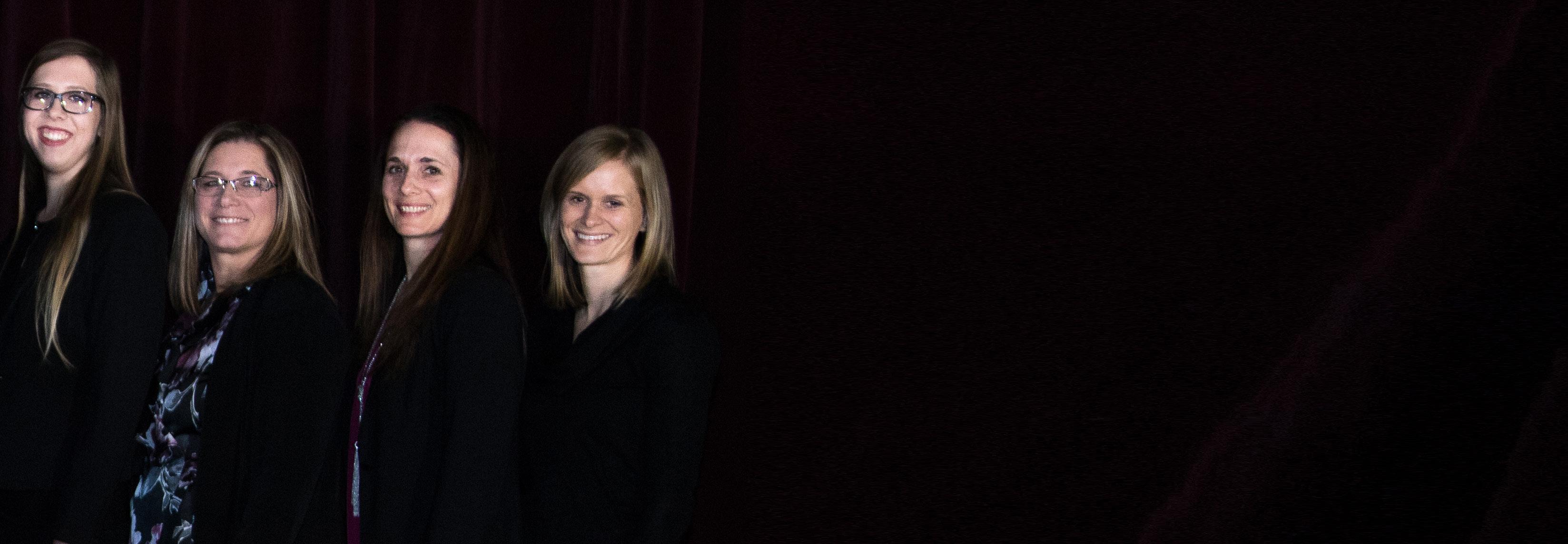
Taking on the role of athletic director is no small feat, but she has received encouraging support from the Concordia administration and campus community. Dr. Lisa Sethre-Hofstad, vice president for Student Development and Campus Life, is thrilled to see the impact Bergeson will have on the department with her knowledge and expertise.
“Rachel’s love for Concordia and her passion for athletics, combined with her wisdom about what’s needed in today’s athletic culture, will be a tremendous asset to our coaching staff and the college,” Sethre-Hofstad said.
While Bergeson’s extensive qualifications and knowledge have prepared her for this role, it’s her love of and connection to Concordia that truly makes her the perfect fit. Now, Bergeson has the opportunity to share the Cobber community with her own kids. From attending baseball games to shooting hoops with the basketball team, Bergeson looks forward to the memories at Concordia she will make with her boys.
“To have the opportunity to provide that same kind of community-family atmosphere for my own kids to grow up in, that’s really special,” Bergeson said. “We not only have built-in babysitters, but my kids have built-in heroes.”
Going to work in a gym makes tagging along with their mom pretty cool, but working each day in a place she loves means it doesn’t feel like work for Bergeson.
“My work is about more than performing tasks on a day-to-day basis. It’s about having an impact on students’ lives and a place that I love so dearly,” Bergeson said. “It’s more than a job – it’s a vocation.” ◊
Abigail Sharpe '19 is a business marketing major from Moorhead.
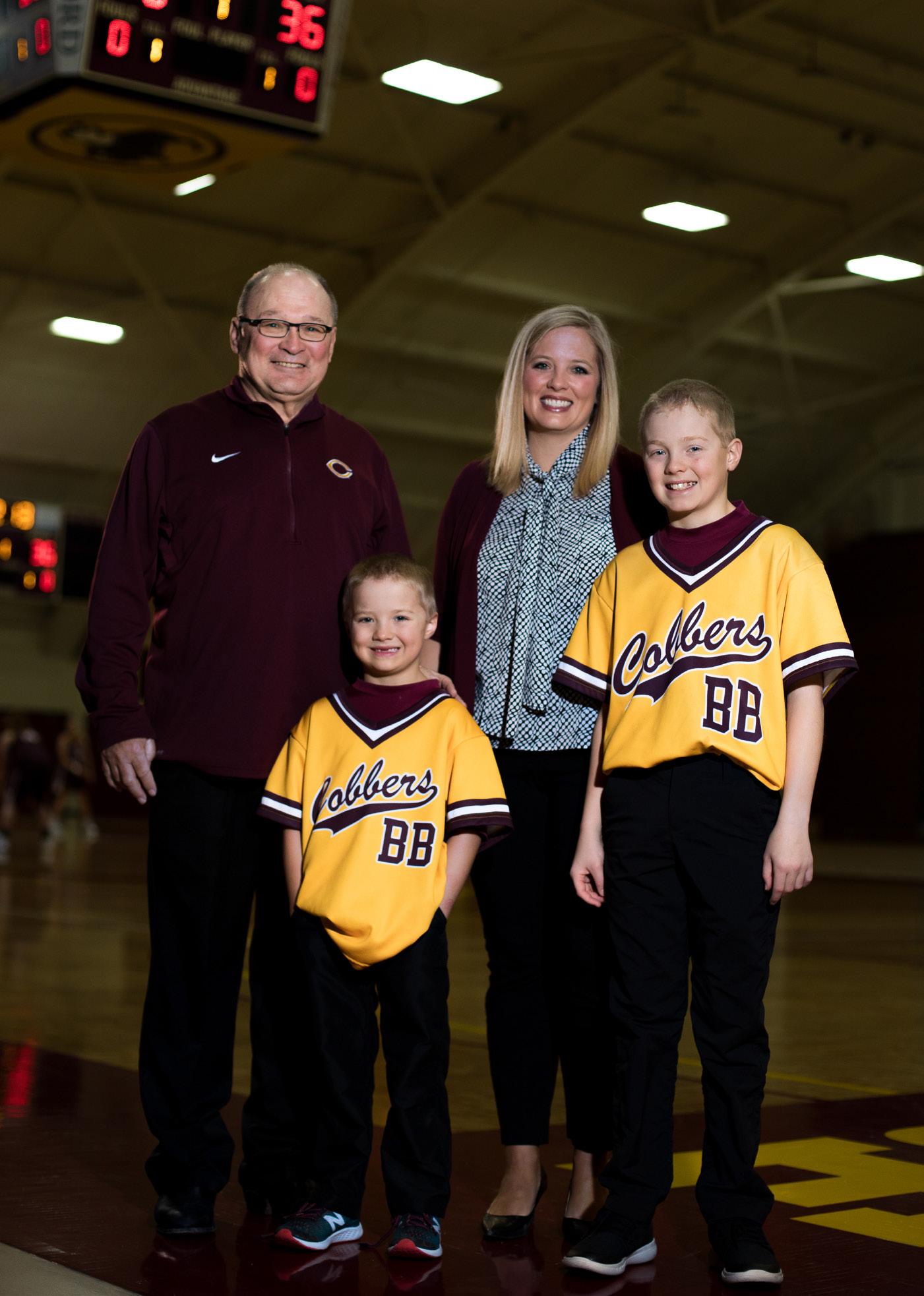
WINTER 2019 | 27
With the addition of four female head coaches this fall, the landscape of leadership in Cobber athletics is shifting. Photo (l-r): Kathleen Vesta, Kari Weidner-Ceniceros, Maureen Greiner, Rebecca O’Shurak, Bergeson, Anneliesse Bruns, Morgan Hoover, Jessica Rahman, Christina Jost and Laura Januszewski
Past, present and future of Cobber athletics: Bergeson with her father, Bucky Burgau, and sons, Tate and Tyden
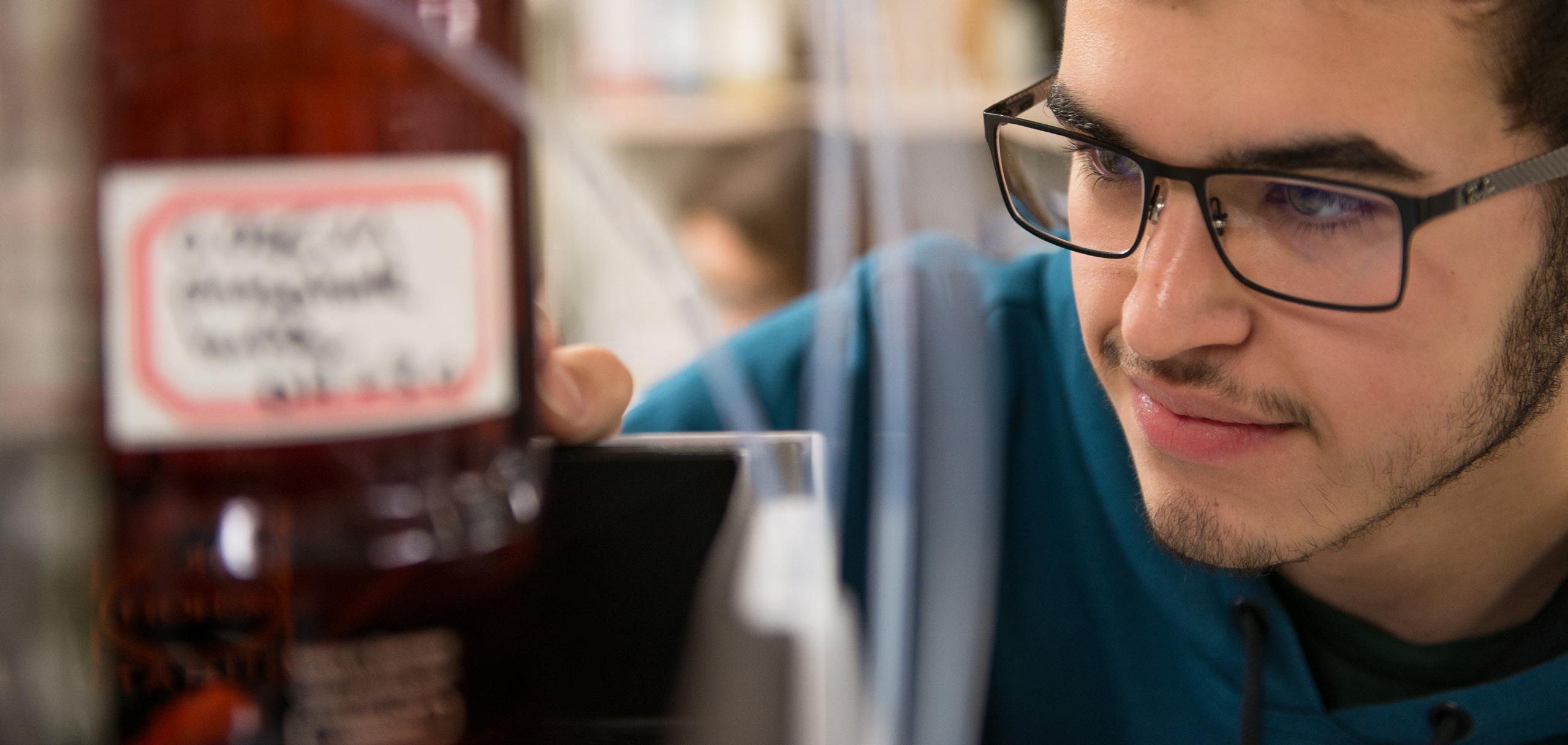
CONCORDIA LAUNCHES NEW PREMED PROGRAM
BY AMY E. KELLY
People who feel called to the field of medicine but lack the prerequisite science courses needed for admission to medical school could benefit from a new program offering at Concordia. The Post Baccalaureate Premedical program is a 12-month program for people who already have an undergraduate degree. The program includes courses necessary for medical school admission and will also prepare students to take the Medical College Admission Test.
“This is more than an MCAT prep course because students also earn the prerequisite credits needed for entrance into medical school,” says Rebecca Amundsen, executive director for Continuing Studies and Outreach.
The new program, offered through Continuing Studies and Outreach, will include coursework in biology, chemistry, and physics and their corresponding labs. Dr. Susan Larson, chair of the Division of Sciences and Mathematics, says this program is an excellent way to leverage Concordia’s strong
baccalaureate premed program. Medical school acceptance for Concordia students is more than 85 percent.
“The cohort will start with summer courses and then be embedded with our undergraduates during the academic year,” Larson says.
Part of the allure of Concordia’s program is the variety of healthcare facilities located in the FargoMoorhead area. With three courses each semester, students will have time and opportunity to work or intern in a health field while taking courses.
Dr. Julie Rutherford, Concordia’s health professions director, says another value-added part of the program is access to faculty expertise for the medical school application process.
“The program will incorporate preparation sessions that will guide students through application requirements, and will encourage work and volunteer opportunities that will allow students to fully
test their commitment to a career in medicine,” Rutherford says. “Our program will provide advice and support beyond completion of the program, including a comprehensive committee evaluation at the time of application to medical schools.”
Larson helped research this new Continuing Studies program. She says the combination of need in the medical field, no other program of its kind in the area, and being able to utilize courses the college already offers makes this a low-risk highreward opportunity for the college. Larson also believes the students in the program, who likely will already have worked in another career, are beneficial to the classes they will take.
“There is excitement around this cohort of students who will enrich the experience of our undergraduate students,” Larson says.
The program is slated to begin summer 2019 and is now accepting applications. The application review process will begin in February. ◊
28 | concordia magazine
Learn more about Continuing Studies programs at ConcordiaContinuingStudies.com

ADVENTURE IS CALLING
Join Cobber alumni and friends to explore the world with us this year.
Feb. 23-March 8, 2019
Tanzania
Drive through the Serengeti Plains and to Tarangire National Park with Dr. James Aageson , retired dean of arts and sciences, and visit a variety of Lutheran missionary projects.
June 24-July 3, 2019
Cycling in Normandy and Brittany
Join President William and Anne Craft for an adventure in France. Historic, scenic, and unforgettably delicious are just a few words to describe this route, which will excite more than Francophiles.
May 5-17, 2020
Vietnam and Cambodia
Combine sightseeing and service in Vietnam and Cambodia with experienced faculty leaders Dr. Polly Kloster and Dr. Gay Rawson . Develop an appreciation for the rich traditions, peoples, and diverse cultures of these lush tropical countries. The itinerary includes Hanoi, Halong Bay, Siem Reap, Angkor Wat, and Battambang.
June 24-July 3, 2020
Germany (Lutherland and Oberammergau)
Join faculty leaders Dr. Roy Hammerling and Dr. Larry Papenfuss on this 12-day trip that will take you to the landmarks and countryside that influenced Martin Luther. Enjoy an opportunity to see the highly anticipated Oberammergau Passion Play, the 42nd decennial production since the 1600s.
WINTER 2019 | 29 To learn more and to register for these adventures, visit ConcordiaCollege.edu/alumnitravel or contact Karen Carlson , Office of Alumni Relations, at carlsonk@cord.edu or 218.299.4335.
Global Travel Opportunities
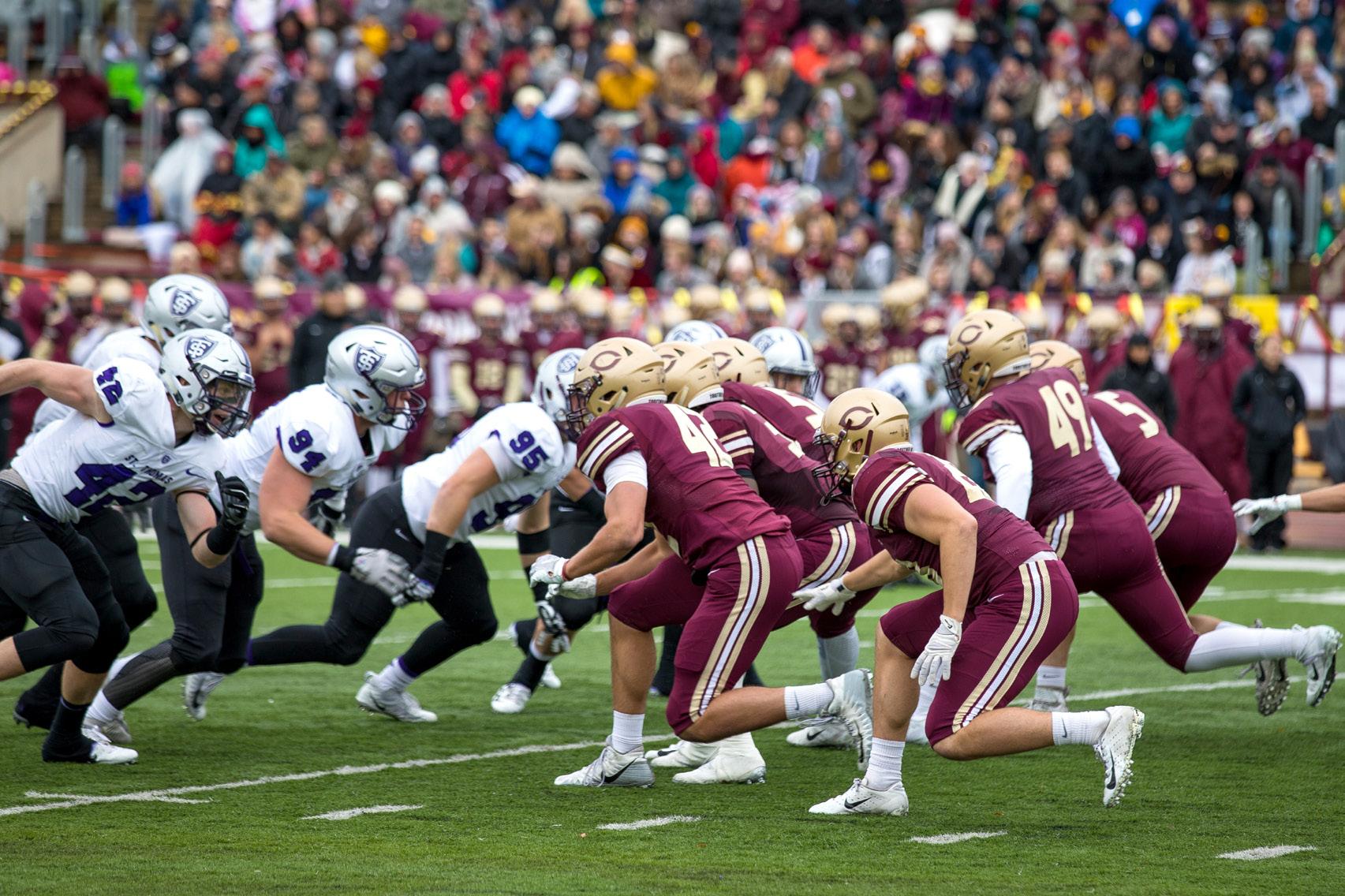


2018 HOMECOMING HIGHLIGHTS Save the Date



Family Weekend 2019
Friday, Sept. 20-Sunday, Sept. 22
ConcordiaCollege.edu/familyweekend
Homecoming 2019
Friday, Oct. 11-Sunday, Oct. 13
ConcordiaCollege.edu/homecoming
Connect with us on social
Follow @concordia_mn and @cobberalumni and tag your photos with #cordmn
Honors
2018 ALUMNI ACHIEVEMENT AWARDS
The Alumni Achievement Award (AAA), the college’s highest honor, is conferred upon alumni (of 20 years or more) who have distinguished themselves in their careers and service to others.

Charles Beck ’48 (posthumous award), a former naval pilot, completed his master’s degree in art at the University of Iowa. He taught printmaking, drawing, painting, and art history at Minnesota State Community and Technical College, Fergus Falls, from 1960-87. A revered Midwest regional artist, Beck produced woodcut prints, woodcarvings, and oil paintings. Known for its vivid representation of Minnesota, his work has been exhibited in the Metropolitan Museum of Art in New York, the Denver Art Museum and the Walker Art Center, among others. A champion for the arts in Fergus Falls, he was honored with several awards.

Darnell Carter ’75 is a retired assistant prosecuting attorney for Clark County, Ohio, where he tried many capital murder cases and was appointed head of the criminal division in 2005. In 1988, he was one of the first to gain a conviction based primarily on DNA evidence, an emerging science at the time. He graduated from Drake University Law School in Des Moines, Iowa, taught English at Springfield South High School and obtained his master’s in history from The Ohio State University. His awards include being named Assistant Prosecuting Attorney of the Year in 2007 and earning the Governor’s Commendation and Resolution.
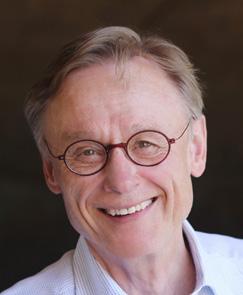
Dr. Richard Sibley ’67 has been the co-medical director in Anatomic Pathology at Stanford University where he has taught pathology since 1986 and led as medical director of clinical laboratories and associate chair for clinical services. A known expert on anatomic and surgical pathology, he received his M.S. at the University of North Dakota School of Medicine (1969) and M.D. at the University of Texas, Southwestern Medical School (1971), then garnered academic training and experience at five prestigious medical centers, including the University of Chicago Hospitals. He has published a daunting 182 professional papers, 23 book chapters and numerous articles.
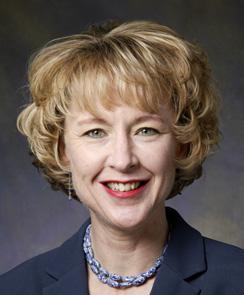
Claudia Swendseid ’78 served 31 years at the Federal Reserve Bank of Minneapolis before retiring as the senior vice president in 2017. During her tenure, she served as a senior officer on the Reserve’s Financial Services Council and as an overseer of many projects and various departments. Her contributions have led to innovation and improvement of many of the Reserve’s processes, notably converting much of its payments from paper to electronic/digital form. She also promoted changes that eliminated operational costs, saving the bank millions annually. In addition, her community involvement includes work with United Way, Community Thread, and Valley Outreach, among others.
2018 SENT FORTH AWARDS
The Sent Forth Award is conferred upon young alumni (of less than 20 years) who have distinguished themselves in their careers and service to others.

Arday Ardayfio ’02 is the founder, president and CEO of Fargo-based Blueprint IT Solutions. A native of Ghana, he worked in college admission, banking and other entrepreneurial enterprises before starting his own business. He is a member of the Fargo Kiwanis Club and served as its president when the organization set a mark recognized by the Guinness World Records for the number of pancakes served in eight hours – 35,000. He was named to Prairie Business Magazine’s 40 Under 40 list for top business professionals and has served on the board at CHARISM.
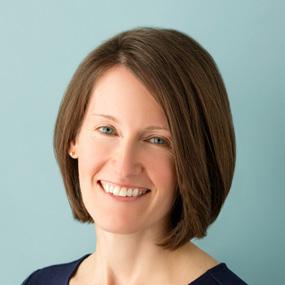
Dr. Tammy Frisby ’99 earned a master’s degree and doctorate in political science from Harvard. Focusing on U.S. government, politics and public policymaking, she taught at Stanford University for nearly a decade. She also served as the executive director and director of research at the Stanford University Bill Lane Center for the American West from 2007-09 and was a research fellow at the Hoover Institution from 2009-17. Refocusing on bioinformatics law and policy, she plans to attend law school at the University of Utah in the fall for biomedical law. ◊
WINTER 2019 | 31
Cobber Photos

It’s a Picnic
Darlene “Andy” (Anderson) Quenette ’58, Art Diercks ’55, John “Jack” Hinman ’55, Muriel (Johnson) Hinman ’55, Jan Severud, Curt Holt

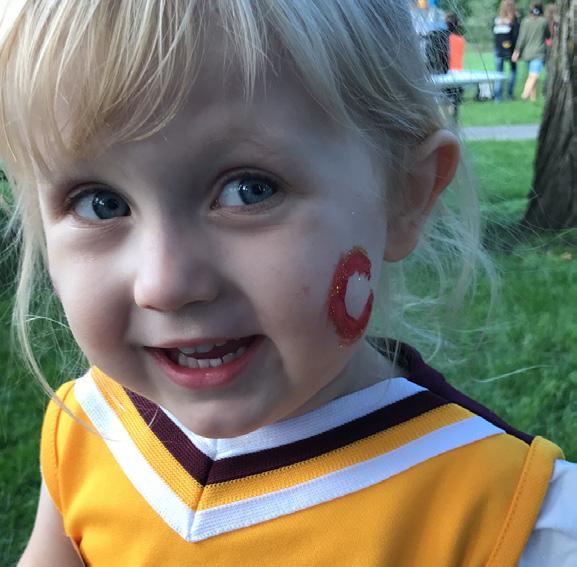
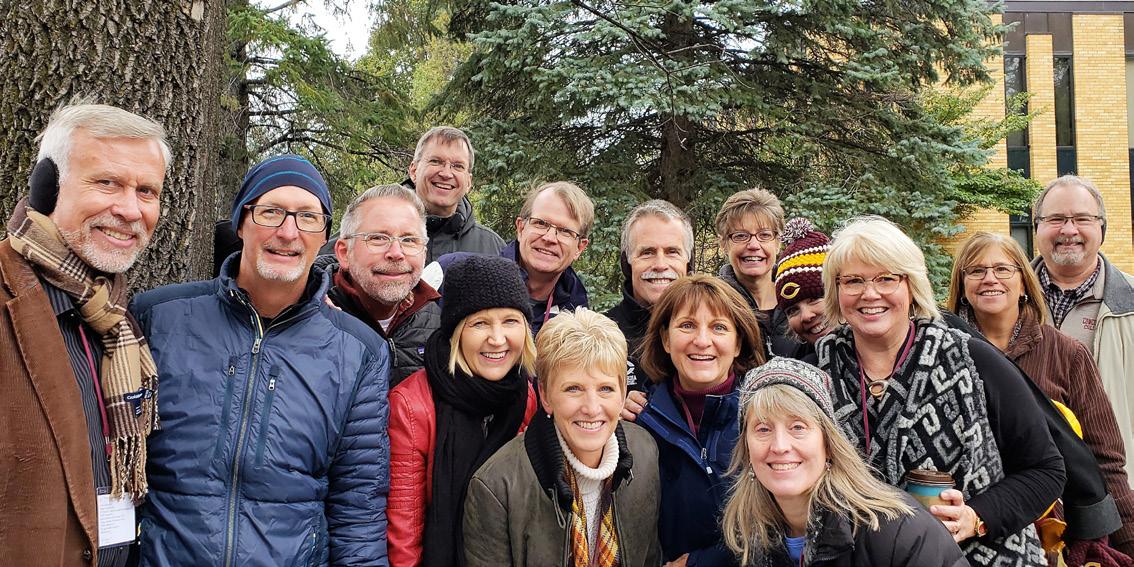
A 35th Homecoming Reunion
Ron Spear, Dave Meldahl, Steve Swenson, Keith Wander, Joann Hall Swenson, Luther Moen, Cyndi (Jacobson) Meldahl, Mark Lillehaugen, Carolyn (Anderson) Lillehaugen, Julie (Brosen) Williams, Darla (Armstrong) Haller [in Cobber hat], Karen (Anderson) Schulz, Kris Hertsgaard Kincaid, Deb (Holtz) Campbell and Scott Campbell

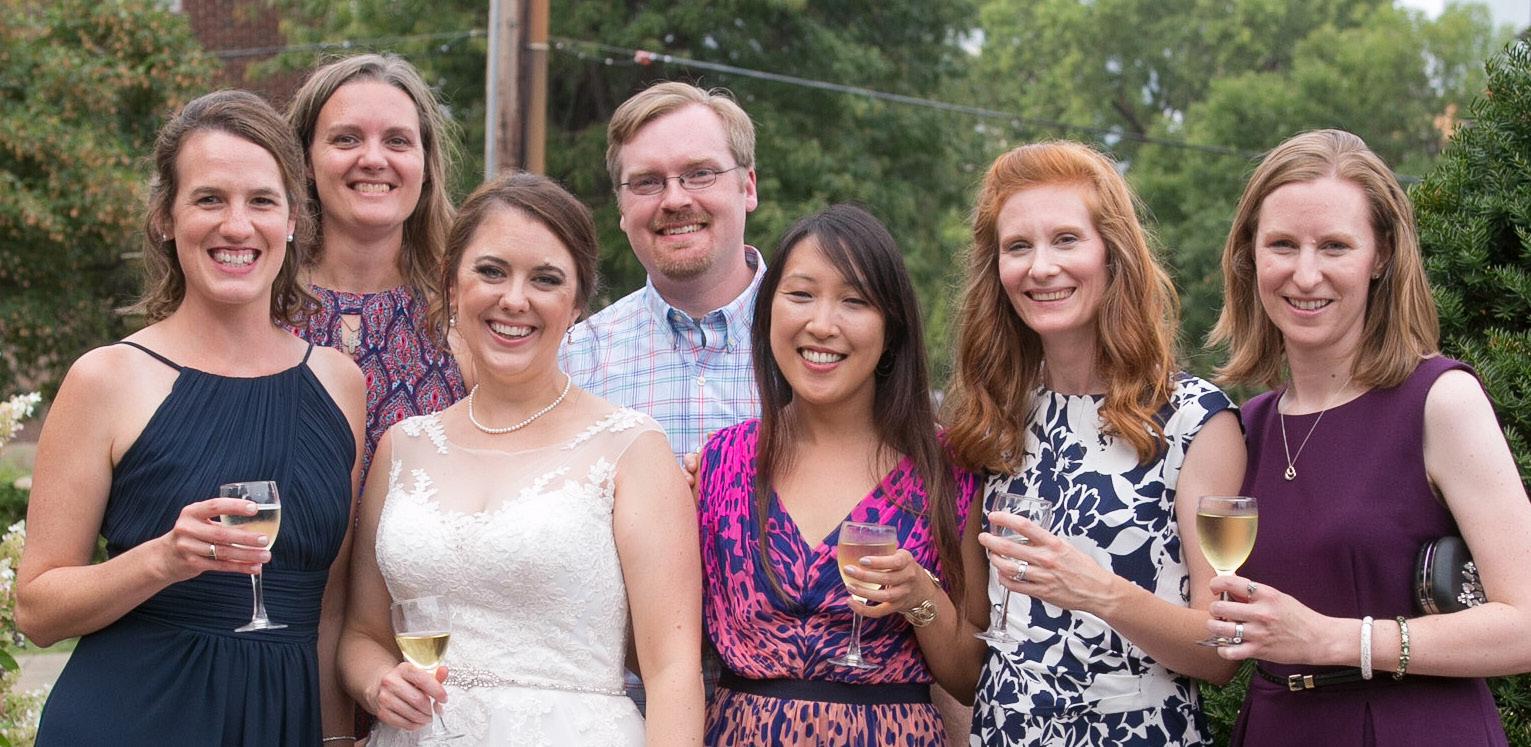


Class notes and photographs may be submitted online at ConcordiaCollege.edu/alumniupdate for inclusion in your class letter. Some photo submissions may appear in the magazine or online at ConcordiaCollege.edu/news
32 | concordia magazine
Future Cobber Ava Johnson, age 3, enjoys the Moorhead Corn Feed; she is the daughter of Randy and Amanda (Halverson) Johnson ’08, West Fargo, N.D.
Lillian “Lily” and her little brother, Marlin, are ready to cheer on the Cobbers; they are the children of Kiaja (Morgenthaler) ’02 and Marlin Klabo III, Shakopee, Minn
Josephine, class of 2039, is the daughter of Lesley Johnson ’06 and Esaul RoblesMojca, El Paso, Texas.
Rory looks ready for Cobberland; she is the daughter of Will and Suzanne (Maanum) Orr ’10, Plymouth, Minn.
Without preplanning, three Cobber alumni had the same idea to show support for their alma mater on College Decision Day at Breck School in Golden Valley, Minn. From left: Sebastien Saunoi-Sandgren ’03, Chris Ohm ’98 and Lissie Nichols ’10
Cobbers from coast to coast celebrated the union of Jennifer Schreiber ’00 and Andy Kempski in Minneapolis. From left: Laura (Lundell) Boyle ’00, Walcott N.D.; Mari (Kadow) Willie ’01, New York Mills, Minn.; the bride, Jenny, Chaska, Minn.; Blake Nyquist ’00, Okemos, Mich.; Susie Dahline ’00, Syracuse, N.Y.; Megan (Bodley) Nyquist ’00, Okemos, Mich.; and Liz (Tepe) Cruz ’00, Kelso, Wash.
Several Cobber grads gathered at Kabekona Lake, south of Laporte, Minn., at the home of Judy and Floyd Anderson ’55 for a picnic in July. Seated (from left): Dick Kuball ’56, Ann Kuball, Ken Severud ’53, Mary Ellen (George) Diercks ’54 and Floyd; standing: Lyle Dahl ’56, Judy (Utke) Stevens ’62, Wanda (Ellingson) Dahl ’57,
’55, Tom Stevens ’57 and Judy
Cobbers from the Class of 1983 gathered next to Lorentzsen at their 35th Homecoming. From left:
Cheer the Ear Cobber Territory
Coast to Toast Future Cobber Class of 2039
Cobber Minds Think Alike
From
MEMORIALS
1932
Viola (Kringler) Braa , 108
1939
Lillian (Syverson) Hackney, 102 // Naomi (Larson) Johnshoy, 98
1940
Phyllis (Crosby) Pratt, 99
1941
Alice (Frykman) Hanson, 99
1942
Geraldine (Amundson) Aslakson , 97 // Helen Garnaas, 97 // Charles Rada , 97
1943
Milo Engelstad, 96 // June (Utne) Swan , 97
1944
Arda (Andersen)
Peterson , 96 // Sylvia (Gaare) Seaton , 93 // Carol (Ingeberg) Stordahl , 94
1945
Signe (Storstad) Brandvold, 96
1946
Judith (Erickson) Hofrenning , 94 // Marjorie (Jenson) Sholy, 93
Julianne (Quamme) Wallin , 93 // Ione (Nettum) Woodford, 93
1947
Beatrice (Lundblad) Clubb, 92 // Mabel Johnson , 97 // Iola (Bjerke) Meyer, 92
1948
Charles Beck , 94 // Joyce (Kvaalen) Carlson , 91 // Russell “Rusty” Halaas, 92 // Sylvia (Lorvig) Olson , 90 // Thelma (Fauske) Sebelius, 94
1949
George Farr, 93 // William Johnson , 91 // Elna (Halmrast) Melbye, 91 // William Raaen , 94 // Ann (Hanson) Stephens, 90
1950
Phyllis (Thompson) Bogart, 89 // Kathryne “Kay” (Baarstad) Hoffland, 89 // Dorlan Lybeck, 90 // Jean (Thompson) Midtbo, 89 // Jill (Harstad) Todd, 88 // Naomi (Graepp) Vining, 89
1951
Ervin Bassen , 93 // Walter Evenson , 91 // Gordon Hanson , 92 // Lois (Beckstrom) Hanson , 87 // Carol (Boxrud) Ilstrup, 91
Richard “Dick” Narum, 88 // Sharon (Austinson) Remark, 89 // Kenneth Rust, 87 // Warren Smerud, 89
1952
Richard Hofstad, 88 // Ann (Gordon) Larson , 88 // Charles “Chuck” Olsgaard, 87 // James Stenerson , 87
1953
Ann (Teigen) Lee, 86 // Arnold Rudi , 87 // Gayle Sobolik , 86 // Albert Thompson , 86
1954
Clarice (Hanson) Burnside, 85 // Adeline (Svendsbye) Elverud, 85 // Don Norem , 87 // Betty (Austin) Roth , 85 // Loren Solem , 89 // Florence (Fiske) Wheeler, 85
1955
Esther (Egeland) Doble, 84 // Ogden Lovdokken , 85 // Allura (Amdahl) Sortland, 84
1956
Wayne Egenes, 84 // Sylvia (Sylvester) Gunderson , 83 // Rodell Lee, 83 // Sheila (Johnsgard) Moore, 83 // Carmen Peterson , 83
1957
James “Jim” Kloster, 87 // Shirley (Peterson) Owen , 83 // Shirley (Melvold) Rourke, 82 // Deane Skjonsby, 83 // Viola (Shannon) Thompson , 83
1958
Gail Aanenson , 81 // Beverly (Meyer) Bjelde, 82 // Maureen “Marcy” (Thompson) Miller, 80 // Rene (Pederson) Moen , 81 // Joanne (Hanson) Negstad, 82 // Doris (Mergenthal) Otterson , 81 // John Teisberg , 81
1959
Robert “Bob” Cobb, 82 // Sandra Grong , 80 // Andrew Hendrickx , 84 // Wayne Lundhagen , 80 // Marion (Musil) Nelson , 80 // Harold “Sam” Skjonsby, 80 // Helen (Sorenson) Stenberg , 83
1960
Carole (Olson) Amb, 80 // James “Jim Dandy” Danielson , 80 // K (Worden) Erickson , 79 // Paul Oium , 80 // Sonja (Lewis) Swanson , 80
WINTER 2019 | 33 memorials »
1961
Judith (Olson) Anderson , 78 // Peter Boe, 80 //
Richard Johnson , 78 //
John Nightengale, 78 //
Wallace “Wally” Pearson , 79 // Robert “Bob”
Stefonowicz, 78
1962
Sandra “Sandy” (Dahl)
Fiechtner Bergo, 77 // Lyle Sannes, 78
1963
Ronald Myrom , 76 // Ronald Rustad, 77
1964
Richard Pett , 76
1965
Larry Anderson , 75 // Earl Johnson , 77 // Barbara (Naugle) Jordahl , 73
// Roger Knapp, 74 //
William MacKellar, 83
1966
John Flaa , 73
1967
Scott Fridlund, 76 //
Landis Haugen , 72 //
James “Jim” Walline, 72
1968
Mark Madson , 71 //
Michael Mokler, 65 //
James “Jim” Parke, 72 //
Susan (Haugen) Sletto, 71
1969
Karen (Jensen)
Christensen , 70 // Marlys Garmer, 70 // John Runquist, 70 // Timothy Tweeton , 71
1970
Terry Knauf, 70 // Loren Synstelien , 70

David B. Boggs, 64, Fargo, N.D., died Sept. 1. Boggs joined the Concordia art faculty in 1985, having previously taught at the University of Illinois and the University of Maine at Machias. Due to his father’s military career, Boggs lived in and traveled across the U.S. and around the world, including Germany and Africa. After serving in the military, he completed his Bachelor of Fine Arts degree at Oklahoma State University and his Master of Fine Arts in painting from the University of Illinois at Urbana-Champaign. Widely known for his paintings, Boggs’ work was shown in hundreds of exhibitions as well as one-person shows. Among his many recognitions was being chosen as one of 20 exhibitors for the critically acclaimed State of the Art 2001, having work shown in the International Biennial Watercolor Invitational and one of 30 painters exhibited at the Kisho Kurokawa-designed National Art Center in Tokyo in 2010 in an exhibition representing the state of watercolor in the United States. His art can be found in collections around the world. Boggs retired from Concordia in 2016. He is survived by his wife, Patricia “Pat” Bastion; his children, Sam (Katie) Boggs and Abby BoggsJohnson (Brent Johnson); and four grandchildren.
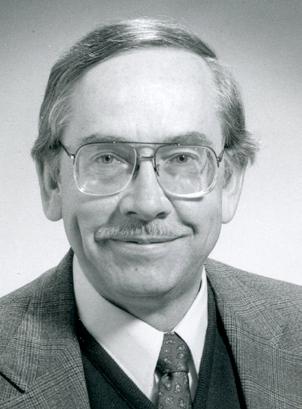
Dr. H. Robert “Bob” Homann, 80, Gold Canyon, Ariz., died Aug. 16. Homann began his 36-year Concordia career in 1964 and retired in 2000. He served as professor of chemistry, department chair, associate academic dean and the first director of the Credo Honors Program. In 1977, Homann was presented with the Sundet Professorship and, in 1967, NASA awarded a research grant to a project under Homann’s direction. In 1990, he was named dean of the college and vice president for Academic Affairs. Following his retirement from Concordia, he was dean of the faculty at Waldorf College in Forest City, Iowa, assisting in the transition from a two-year to four-year institution. Homann earned his undergraduate degree from Beloit (Wis.) College and his master’s from Washington State University, Pullman. From 1979 to 1985, he and his wife participated in the Danforth Associate Program – unique because spouses were also considered associates in recognition of their role as contributors to the college and community. Its goal was to increase the effectiveness of learning and teaching on college campuses by humanizing the learning experience. Homann is survived by his wife, Dorothy; his daughter, Kelli (Brad) Mack; and five grandchildren.
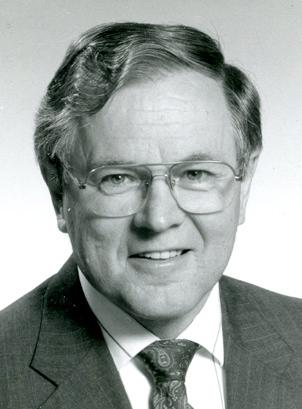
Dr. William J. MacKellar, 83, Punta Gorda, Fla., died Oct. 11. MacKellar graduated from Concordia in 1965 with a degree in chemistry and mathematics and received his doctorate in analytical chemistry from Wayne State University, Detroit. He also actively served eight years in the U.S. Air Force. MacKellar returned to Concordia and served for 28 years in the department of chemistry. He also served on the BuffaloRed River Watershed management district in northwest Minnesota. MacKellar was active in chemistry research, resulting in a number of scientific publications, and was instrumental in introducing computers to the chemistry department. He retired from Concordia in 1997 and taught chemistry part time at State College of Florida, Venice, until he retired in 2010. He is survived by his wife of 25 years, Tina; his son, Steven MacKellar; daughters, Vicki (William) Jacobsen, Nancy MacKellar and Julie (Josh) Noe; stepsons, Randall (Beth) Johnson and Brian Johnson; six grandchildren and three stepgrandchildren.
« memorials
34 | concordia magazine
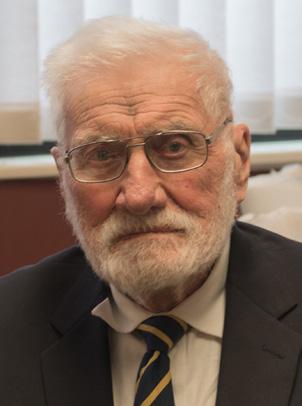
Dr. Olin J. Storvick, 92, Moorhead, died June 16. Storvick, widely recognized as one of the giants in the history of the college for more than 60 years, joined the classics department in 1955 and retired in 1995 but maintained a continued presence at the college. He twice served as associate dean of the college and received the Reuel and Alma Wije Distinguished Professorship in 1988. The college established the Olin J. Storvick Endowed Chair of Classical Studies in 2002 and honored him with a Doctor of Humane Letters, honoris causa, in 2017. He earned his undergraduate degree from Luther College, Decorah, Iowa, after being called to active duty by the U.S. Army. He served on Okinawa and was awarded a Purple Heart. He received his master’s degree and doctorate from the University of Michigan. Storvick began archaeological excavations in the Middle East in 1970 and continued this research for decades, bringing students into the process. In 1993, he and a group of students discovered 99 fourth-century Byzantine gold coins at an excavation site in Israel, one of the largest hoards of privately owned gold coins ever discovered from this period, and the finding was highlighted by international and national media. His wife of 65 years, Ruth, preceded him in death. He is survived by his daughters, Helen (David) Saude, Solveig (Steven) Pollei and Karen (James) Markert; sons, Rolf Storvick (Karen Lund) and Eric Storvick (Diane Reque); 12 grandchildren and seven great-grandchildren.
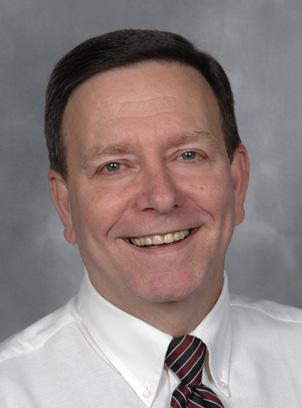
Henry “Hank” T. Tkachuk, 69, Moorhead, died Sept. 13. Tkachuk served as professor of communication studies and theatre art and was co-director of the Oral Communication Center. He began his Concordia career in 1972 and retired in 2016. He served as debate coach, as department chair for 15 years, and led some of the earliest May Seminar programs – 18 seminars that included 28 countries. In 2003, he was awarded the Ole and Lucy Flaat Distinguished Teaching Award. Tkachuk earned his undergraduate degree from Augustana College in Rock Island, Ill.; a master’s degree from Bradley University, Peoria; and pursued doctoral studies at Purdue University. A longtime volunteer for refugee resettlement programs in the area, in 1993 he participated in a Knight Foundation Grant faculty study trip to India and returned to India in 1995 to live and study as a visiting professor at Gurukul Lutheran Theological College. Later he was a guest lecturer at Madras University, speaking on his research in intercultural communication. He and a colleague presented a paper on “Student Ethnocentrism Before and After September 11” to the UNESCO Conference on Intercultural Education. He is survived by his wife, Lynn; his daughters, Rebecca Tkachuk (Jonathan Swoyer), Lea Tkachuk Nerby (Nathan) and Victoria Tkachuk Owen (Nick); and nine grandchildren. ◊
1971
Larry Correll , 69 // Paul Fredrickson , 68
1973
Stanley Gordon , 66 // Margaret (Hayford) O’Leary, 67
1976
Wendy Amundson , 63 // Audrey Stottler-Poppe, 65
1977
Kristina (Torkelson) Gray, 62
1979
Gloria (Gredvig) Mitchell , 62
1980
Douglas “Doug” Brekke, 59 // Jean (Weber)
Hertsgaard, 61 // Peter Trier, 61
1981
Elizabeth “Liz” (Hammer) Watters, 59
1983
John Pearson , 57
1986
Douglas “Doug” Lafontaine, 53
1988
Michael Twedt, 52 // Judith “Judy” (Anderson) Woods, 73
1989
Vicky (Held) Westra , 51
1993
Kaia Heide, 47
1995
Nicole (Berg) Names, 45 // Luke Pedersen , 45 // Angel Salathe, 45
1998
Nathan Hancock , 43 // Darcy (Thompson) Jacobson , 42
1999
David “Dave” Bigelow, 46
2000
Susan “Sue” Rhea , 49
2003
Rachel (Clarens) Farnsworth , 36
2004
John Anderson , 36 // Steven Peterson , 35
2006
Joshua “Josh” Dietz, 34
2010
Adam Gilbertson , 29
2011
Jaynie (Herbranson) Halvorson , 28
WINTER 2019 | 35 memorials »


Charles Beck Life Imitating Art
By Laura Caroon
Art may imitate life, but fans of Charles Beck ’48 know the opposite can also be true.
Gently rolling hillsides.
A farmer’s field dotted with migrating birds. Rows of yellow birches against a clear blue sky. A glorious sunset revealed through the trees.
It’s not uncommon for someone to pause to take a second look at one of these familiar scenes of lakes country and think to themselves, “That looks like a Beck.”
Beck’s art captured scenes of nature and life in the Midwest, which captured the attention (and hearts) of Minnesotans and collectors around the world.
Inspiration was all around Beck in his hometown of Fergus Falls, Minn. He would drive his pickup through the countryside until something caught his eye. He’d then sketch out what he saw: from the lakes to the sky, the wheat fields to the hills, the farmhouses, trees and birds.
From a very young age, Beck loved drawing and creating cartoons. He always knew he wanted to be an


artist, but there were no art classes in school in Fergus Falls. So, by default, Beck was a self-taught artist until he enrolled at Concordia.
Beck never considered going to college to study art, but he was also a gifted athlete and was recruited by Jake Christiansen to play football for the Cobbers. When Beck told his coach that he wanted to be an artist, Christiansen encouraged him by affirming, “The world needs artists, too.”
Beck played football, basketball, and baseball and ran track for the Cobbers. He also worked as an art editor for The Concordian student newspaper, where he drew sketches of athletes and created artwork for ads. Beck was an art major and had the good fortune of studying under the head of the art department, Cyrus Running. Running was not only his first art teacher, but he also became Beck’s mentor and close friend.
In 1943, Beck’s college career was interrupted when he enlisted in the Naval Air Corps. He trained as a pilot, but the war ended before Beck was deployed. Upon his return and graduation, Running encouraged Beck to take advantage of the GI Bill and apply to the University of Iowa for a Master of Fine Arts degree.
36 | concordia magazine

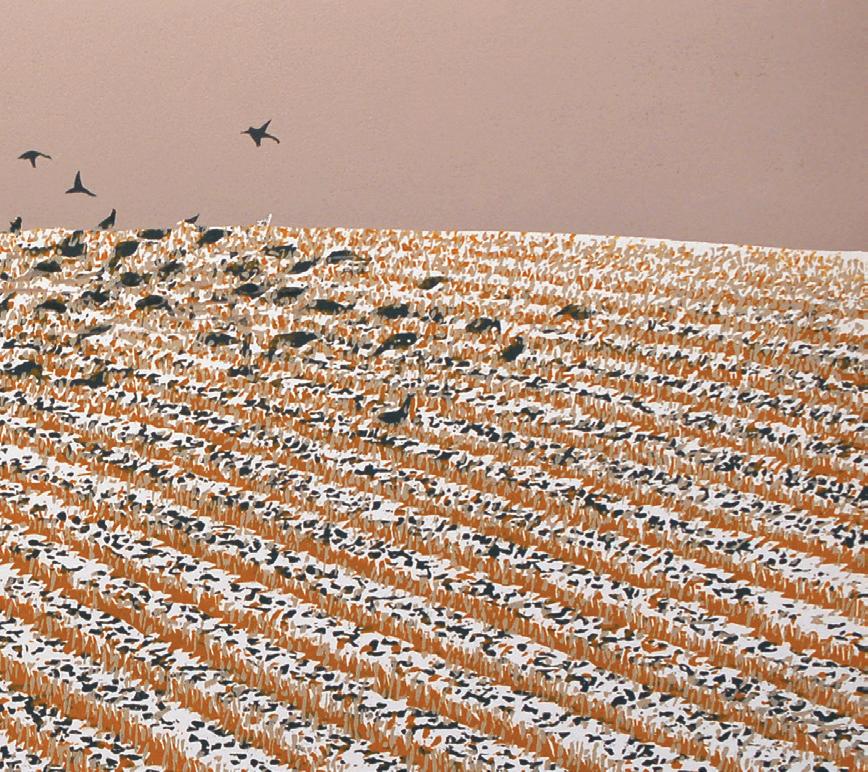

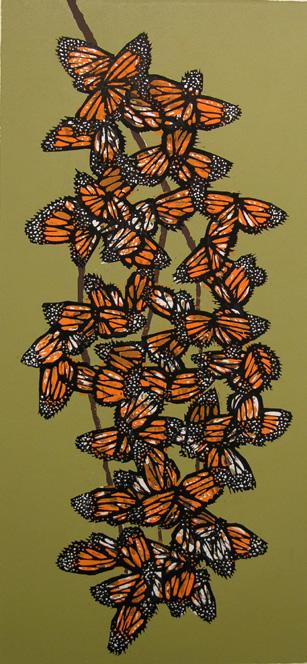
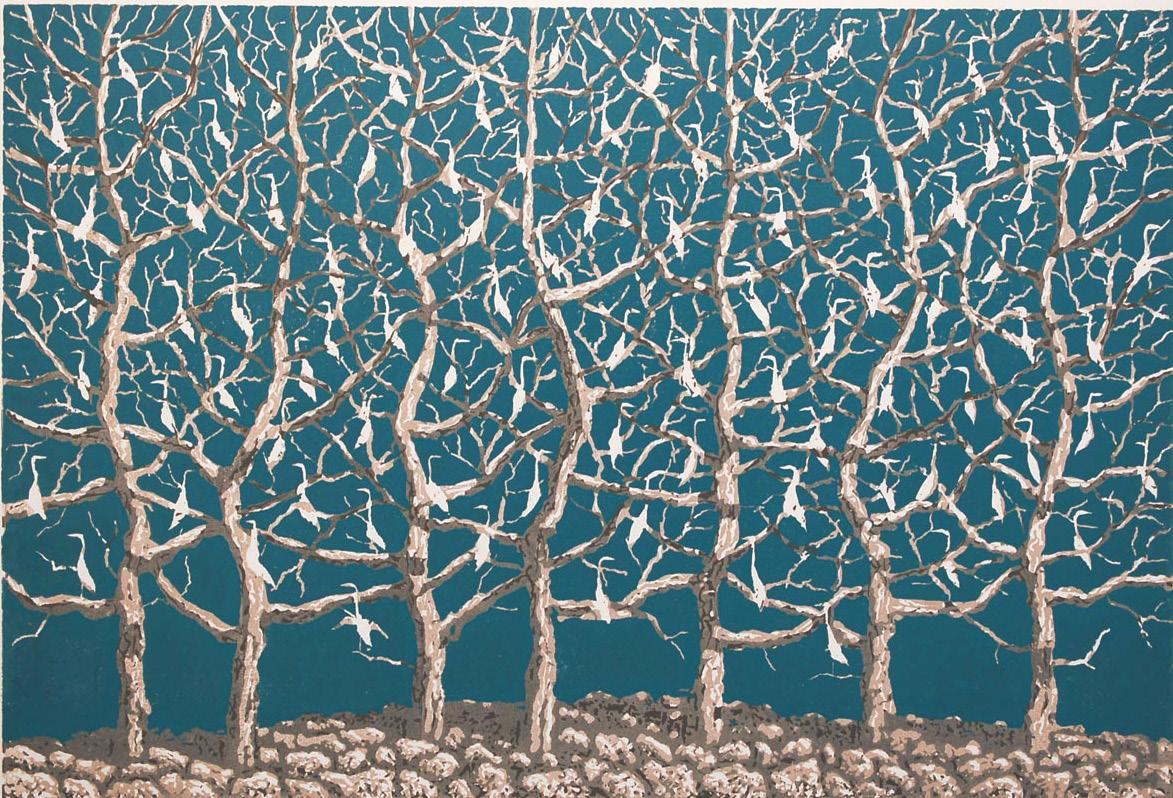
After completing his MFA, Beck moved back to his hometown and supported his growing young family as a sign painter. There weren’t many opportunities for artists in Fergus Falls, so Beck painted advertisements, sales signs and even the sides of local grain elevators.
But in 1960, a new junior college in town (now M State) was looking for a part-time art instructor and Beck’s teaching career began. He spent 28 years teaching art history, drawing, painting and lettering classes. It was a perfect situation for Beck because he got to share his love of art with his students and also had time to continue to work on his own art.
Beck was a skilled painter and woodcarver but became most known for his iconic woodcuts. He carved images in reverse into soft basswood, then coated the wood block with ink and pressed it onto paper. Each color required carving a different wood block, sometimes totaling five wood blocks to complete the print.
Beck became one of Minnesota’s most well-known and prolific artists. During his career, he created more than 250 woodcuts and sold hundreds of prints. His pieces were shown in galleries across the region including the Metropolitan Museum of Art, Walker Art Center, the Rourke Gallery and the Plains Art Museum.
Though Beck passed away in 2017, his legacy continues to be an inspiration. From soft pastel skies over a lonely farmhouse to the brilliance of autumn colors reflecting on a lake, Beck’s art was a reaction to the place he loved most in the world.
Beck’s daughter, Carolyn Glesne, said teaching others to have an appreciation for art gave Beck his greatest satisfaction.
“My father’s unique representation of nature caused people to react. He was encouraged when, through his art, they related to their surroundings,” she said.
Each time someone is reminded of his art and takes an extra moment to notice the natural beauty around them, Beck’s passion for nature is realized. ◊
Beck’s work is currently featured at the James J. Hill House art gallery, 240 Summit Ave., St. Paul, Minn. “Charles Beck: An Artist for All Seasons,” which includes more than 40 works by Beck including prints, paintings and woodcarvings, is open now through Feb. 24.
WINTER 2019 | 37
WATCH THE VIDEO ConcordiaCollege.edu/beck
CHANGE SERVICE REQUESTED
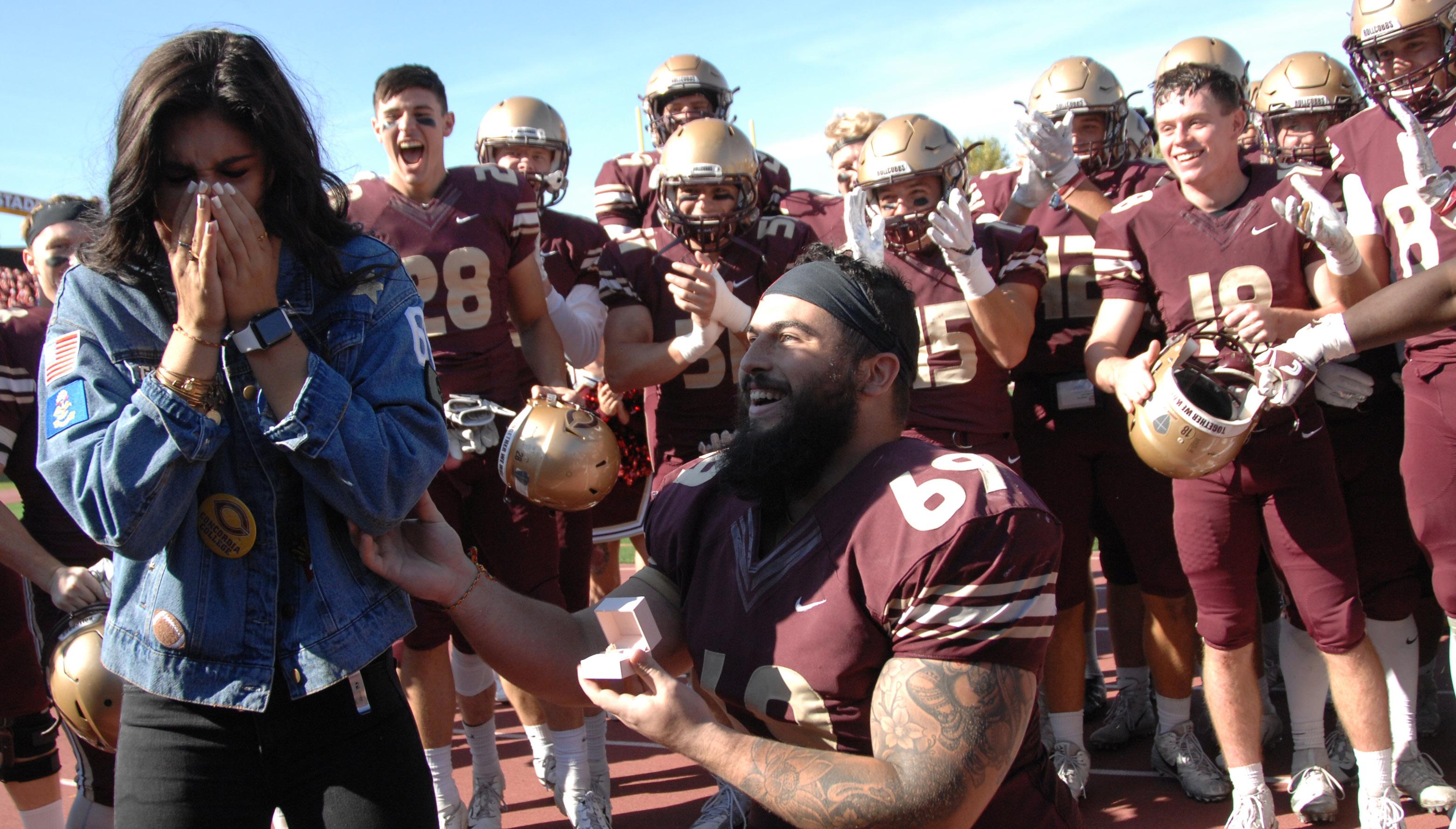
Use #cordmn to share your posts and images with us.
8th St. S., Moorhead,
901
MN 56562
NONPROFIT U.S. POSTAGE PAID CONCORDIA COLLEGE
With the help of the Cobber football team, Gunnar Kollman ’19 surprises Adelina Johnson ’19 with a proposal at the Concordia vs. Hamline game at Jake Christiansen Stadium on Sept. 22, 2018.
connect


 President William J. Craft
President William J. Craft


















































































